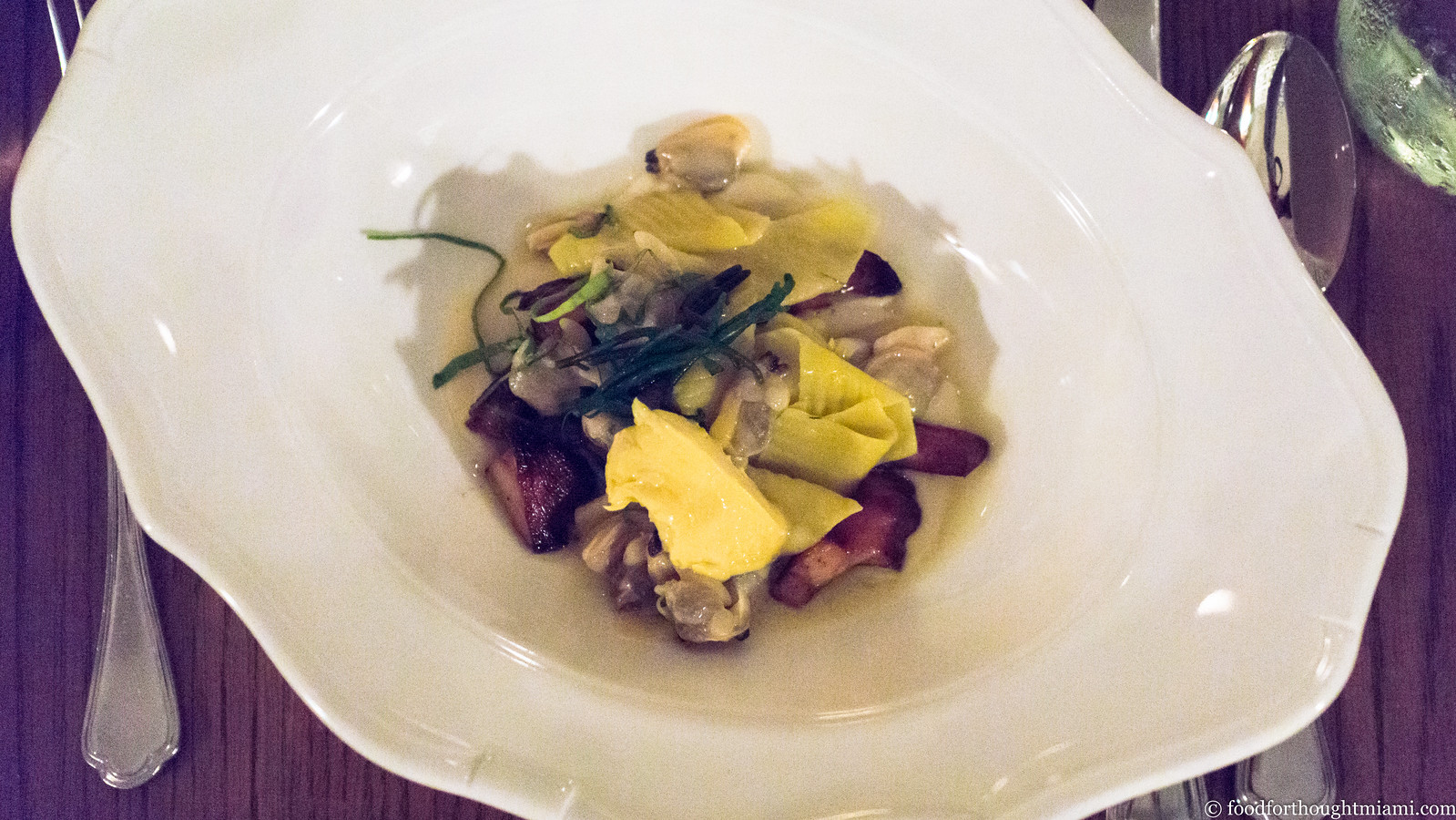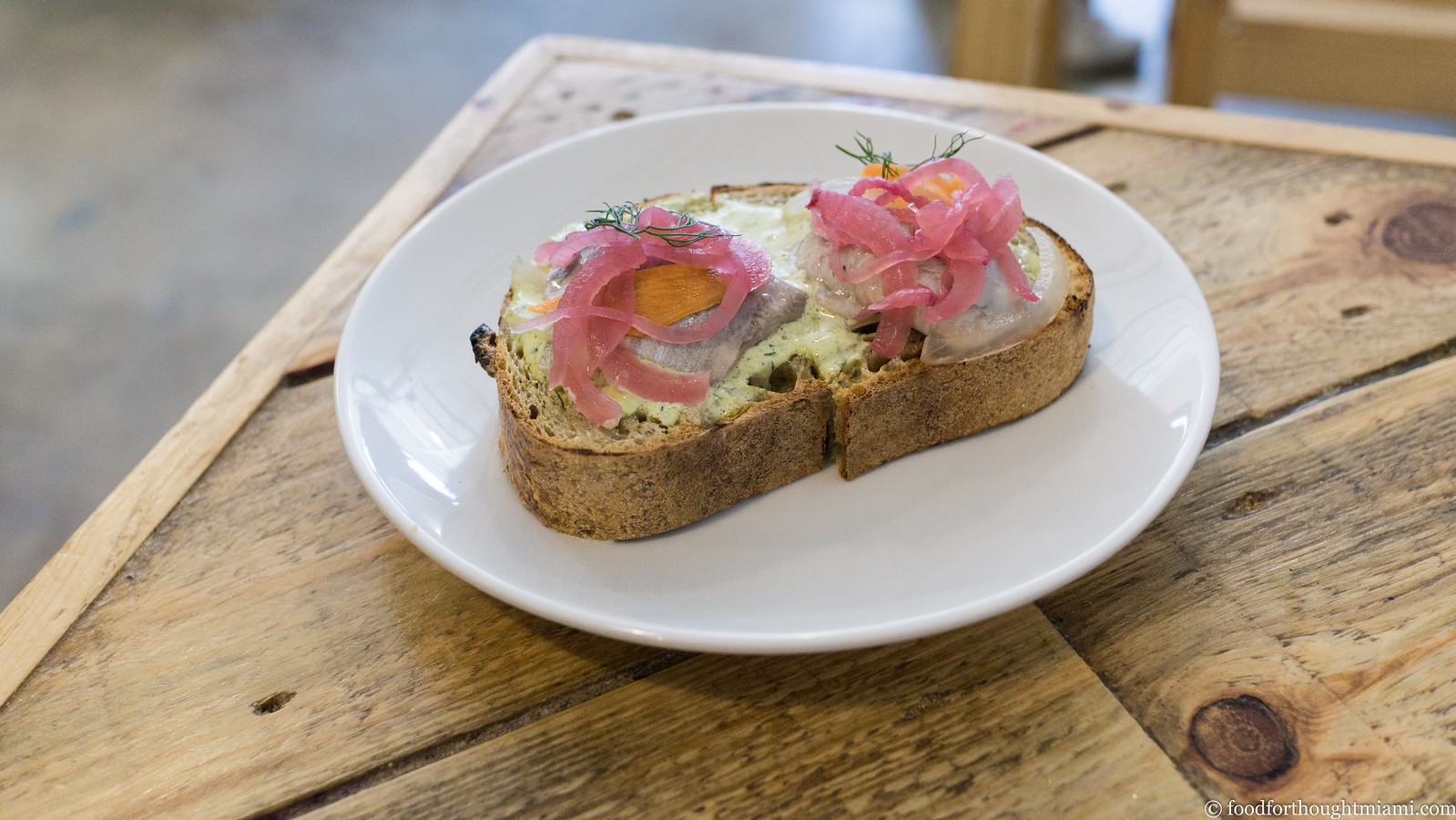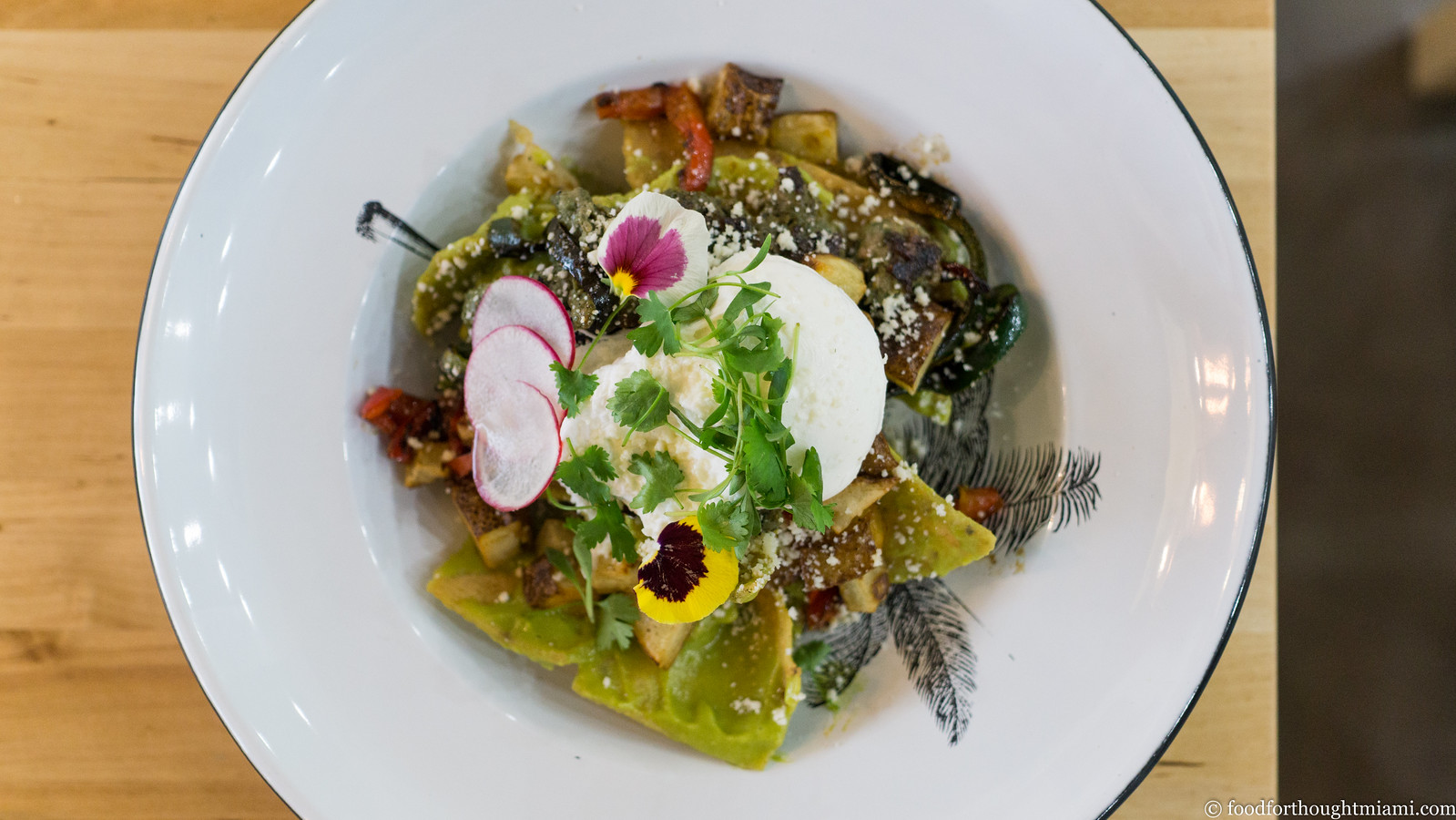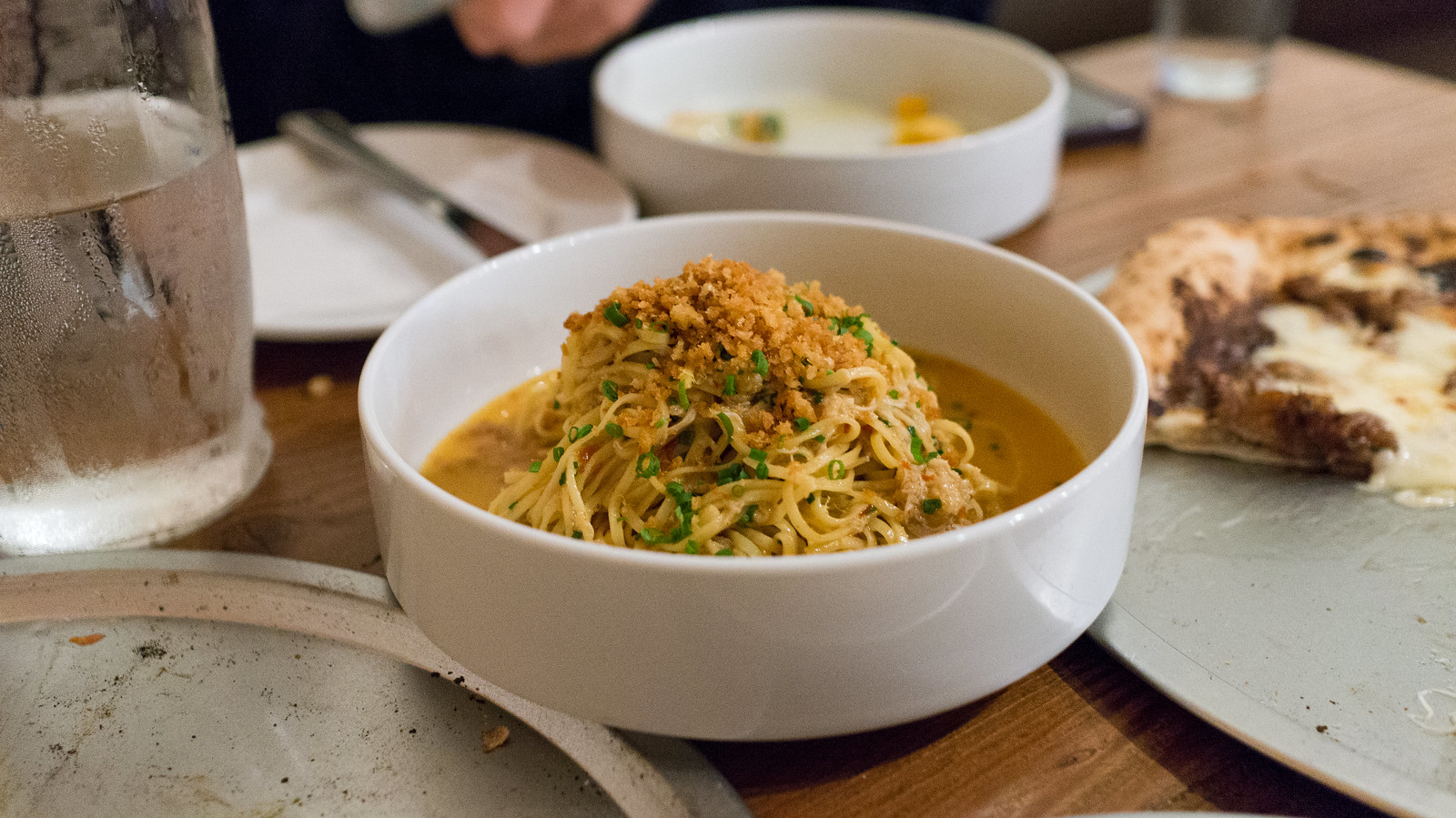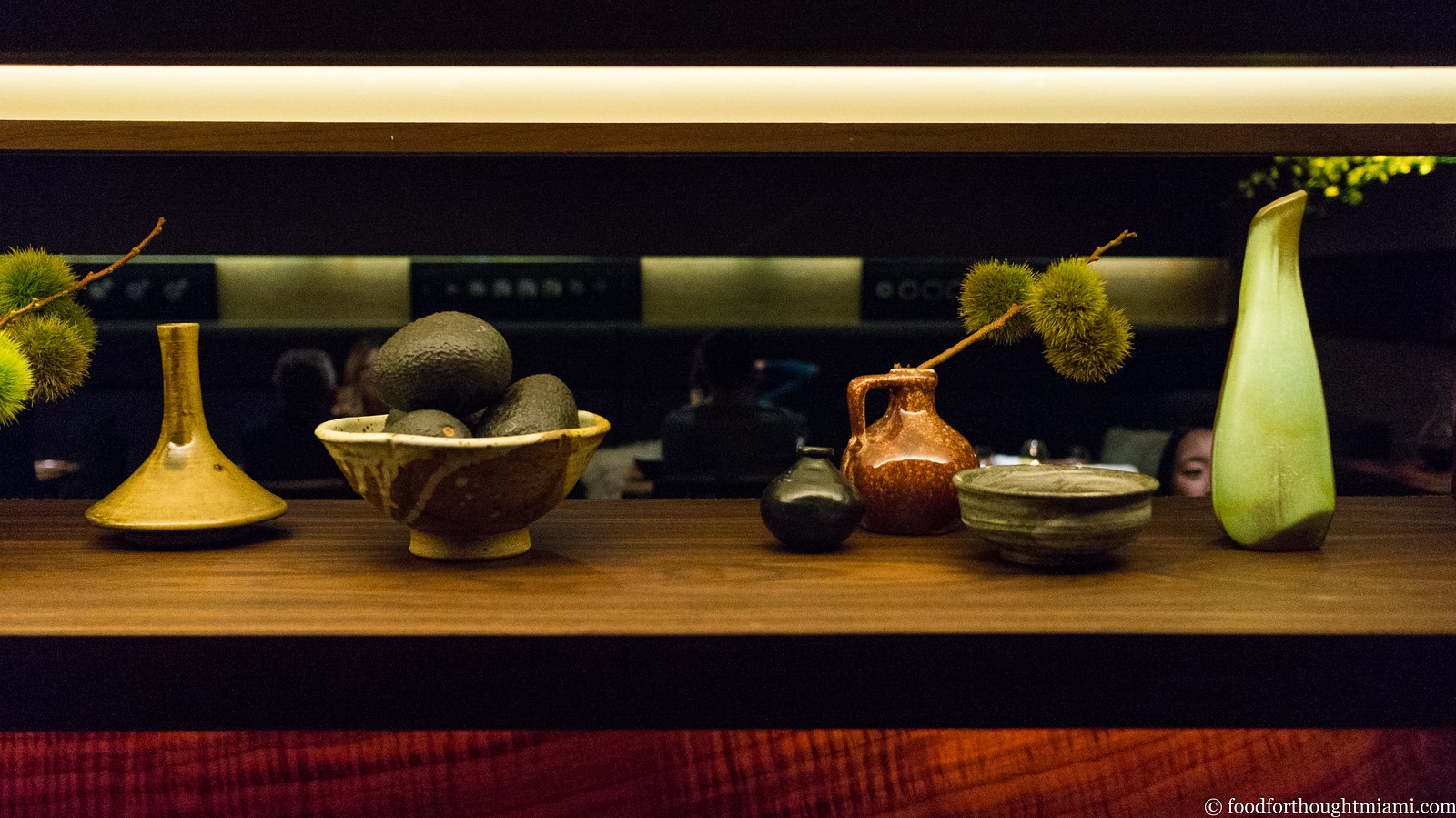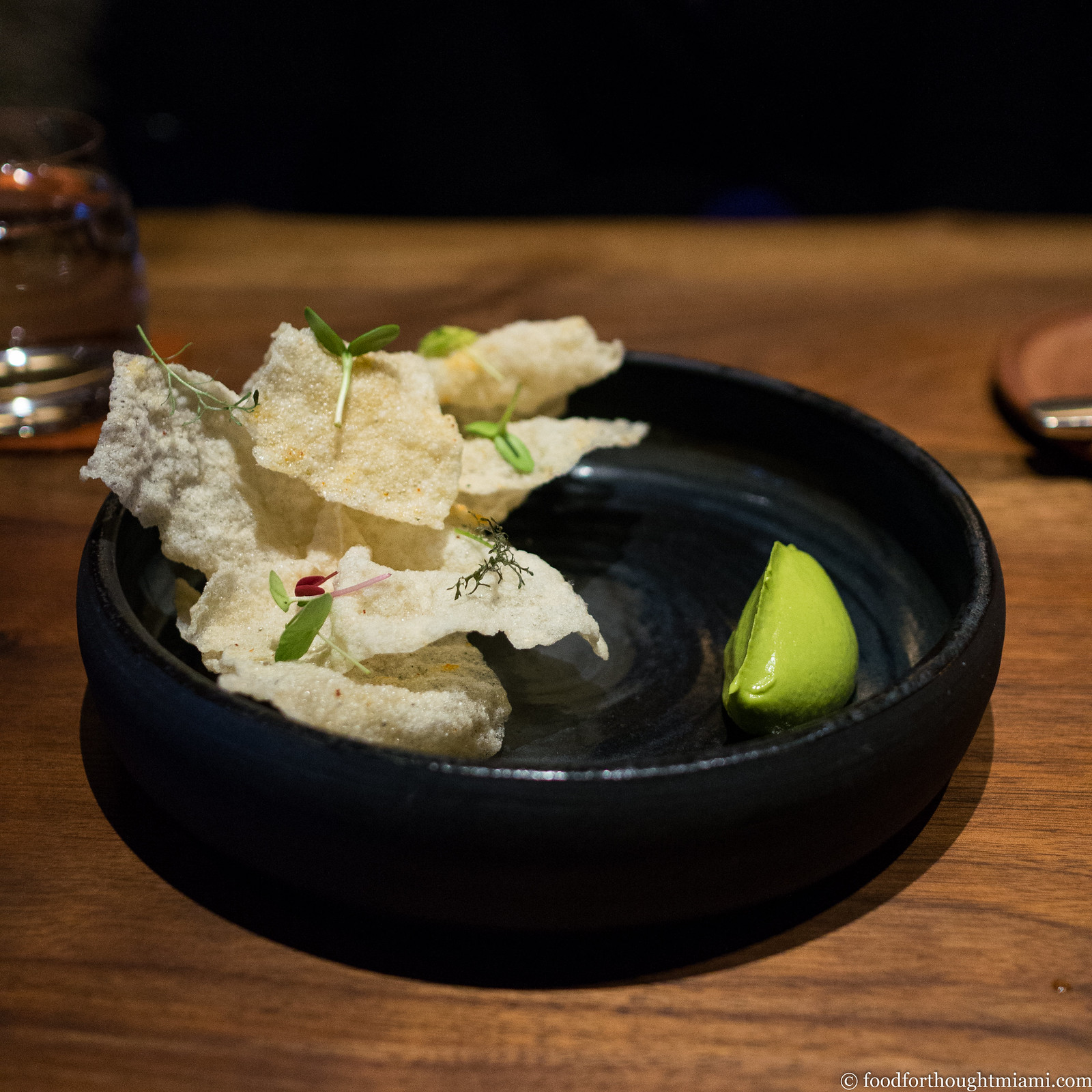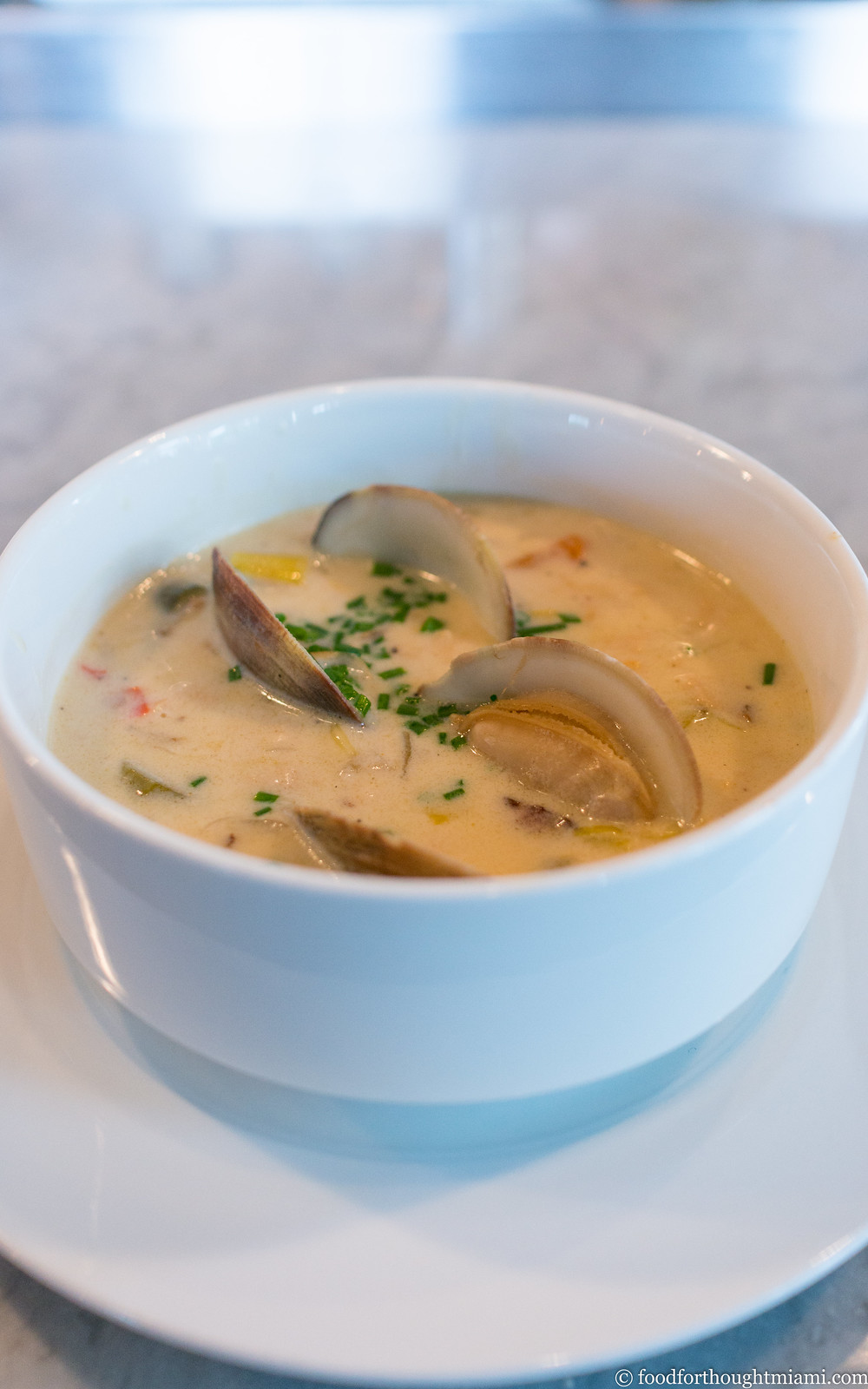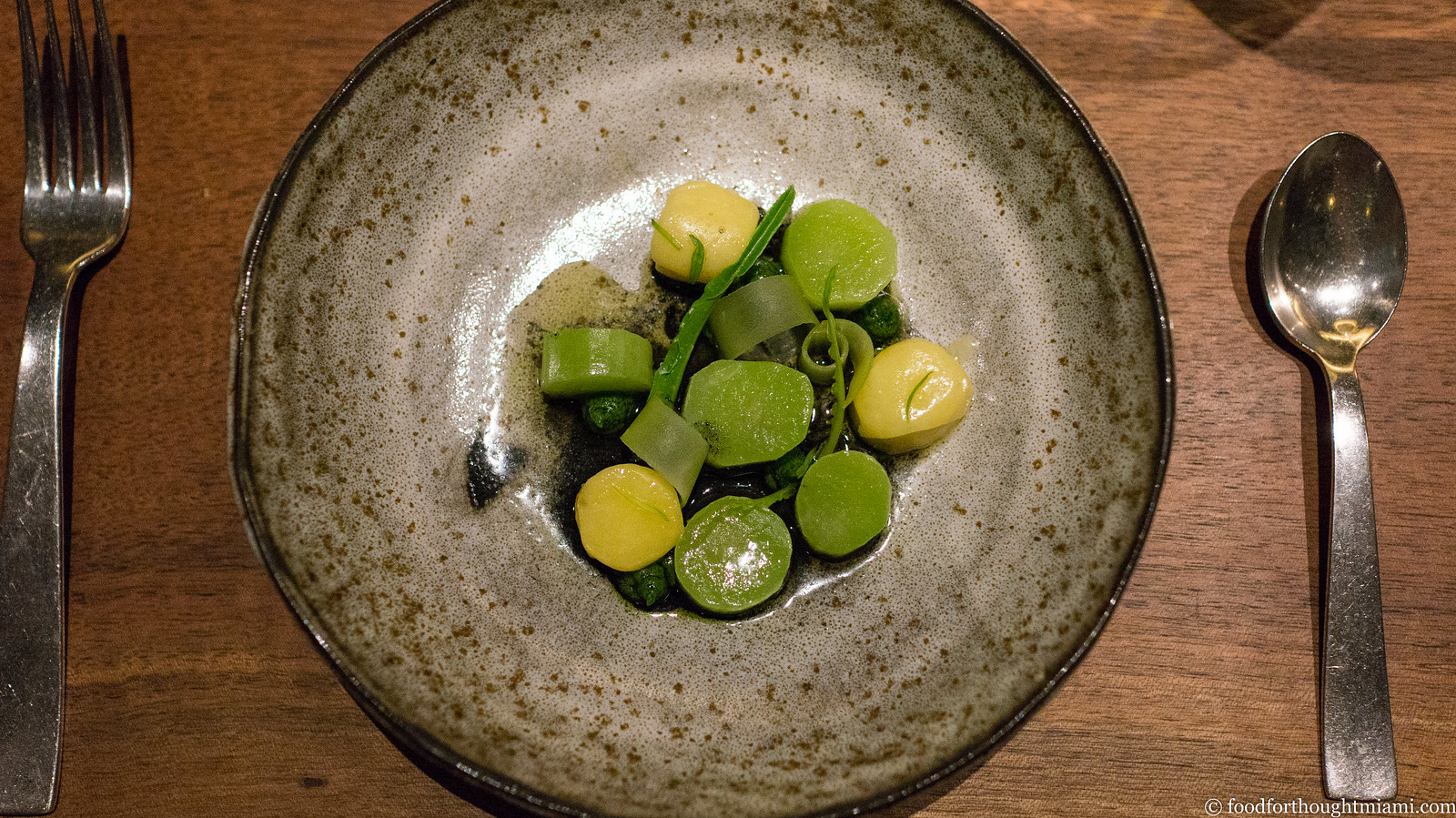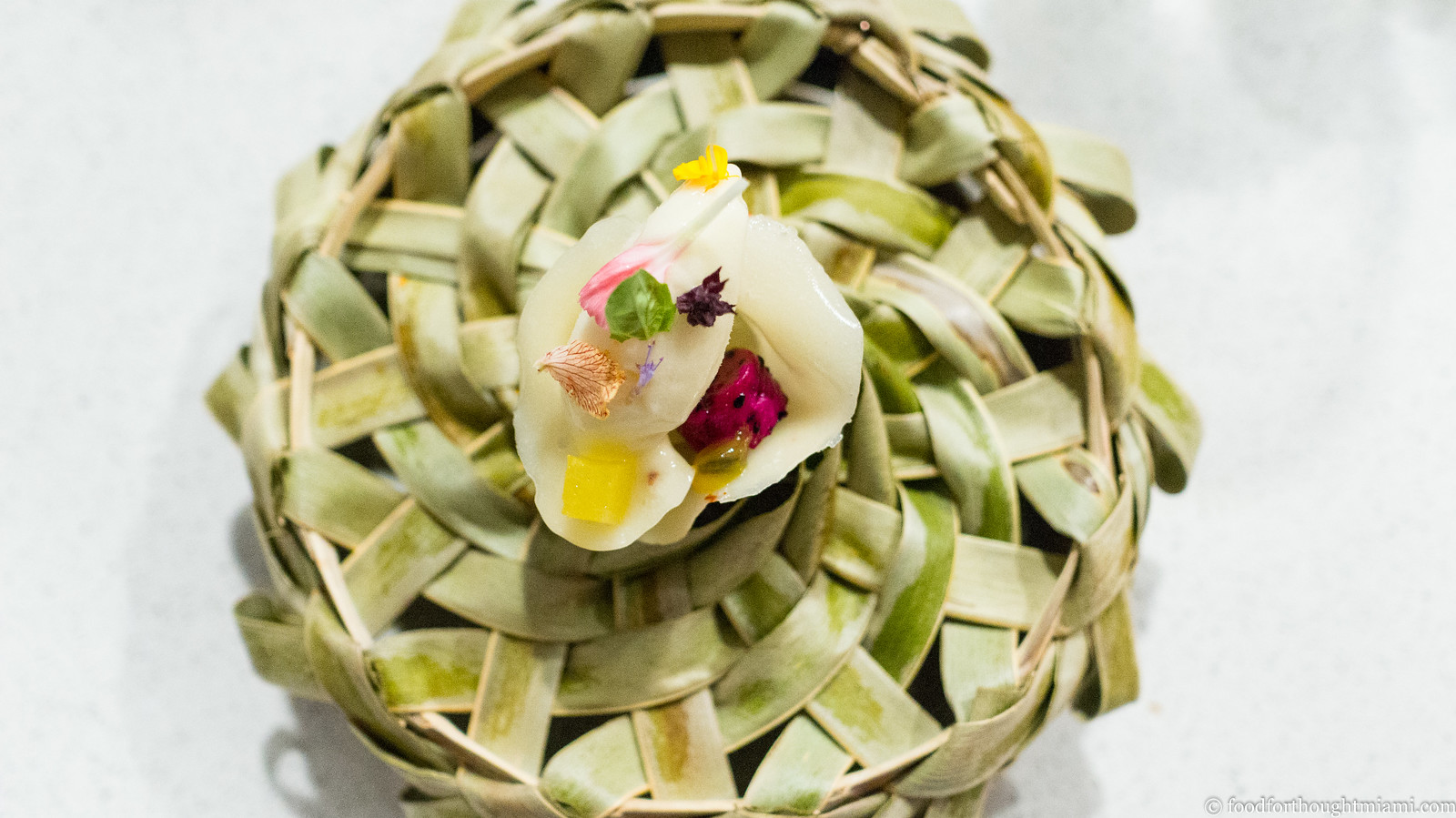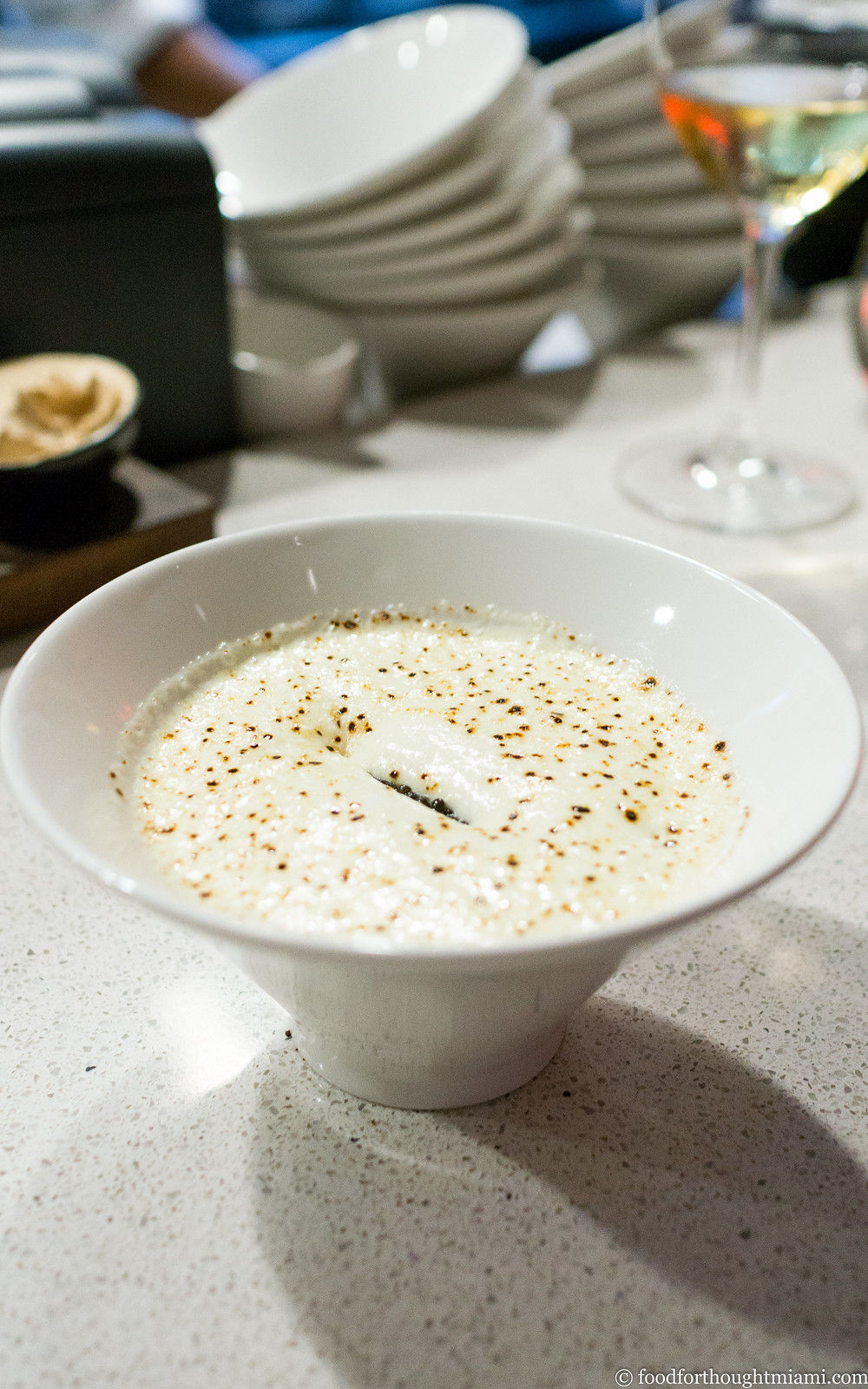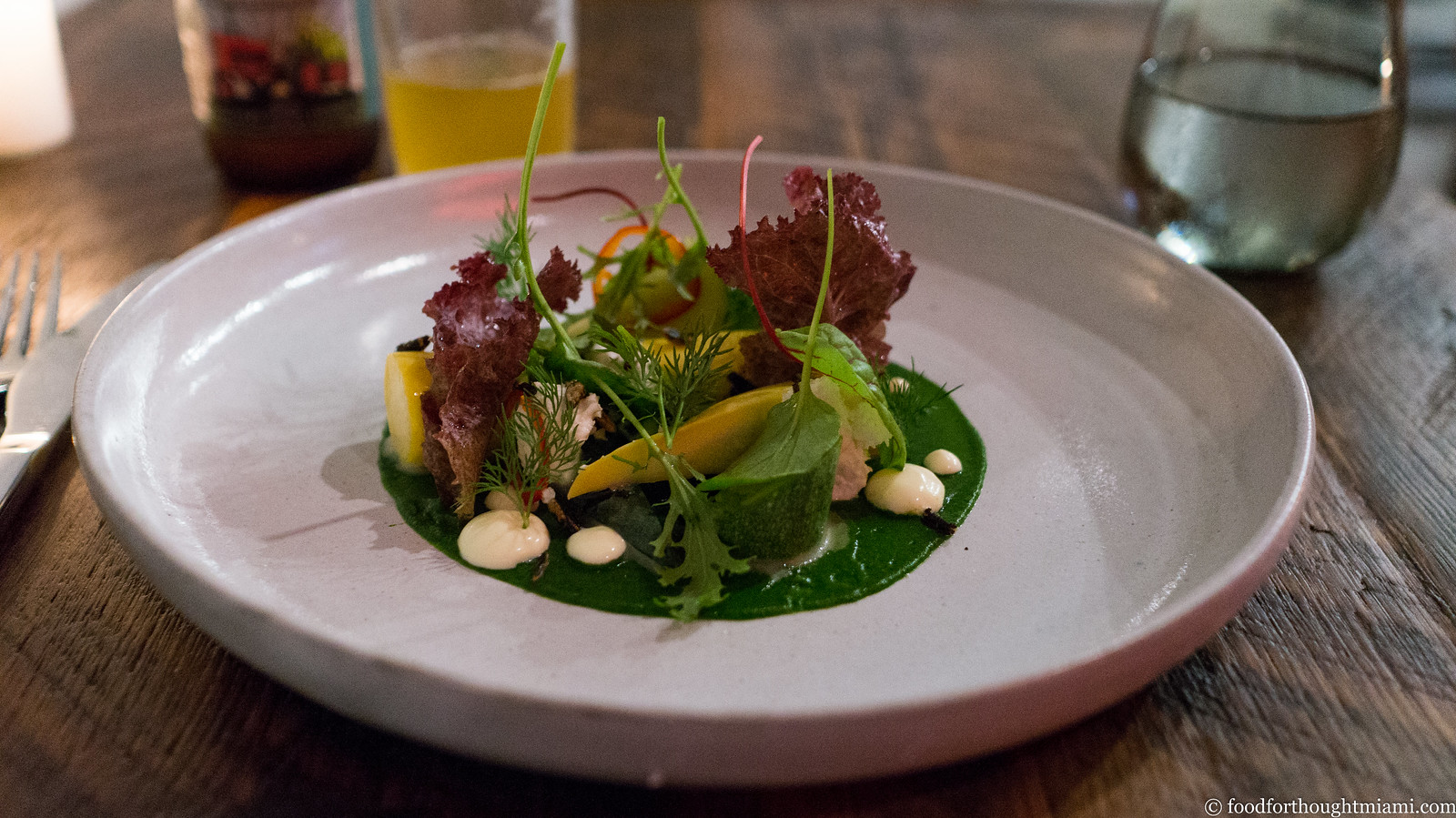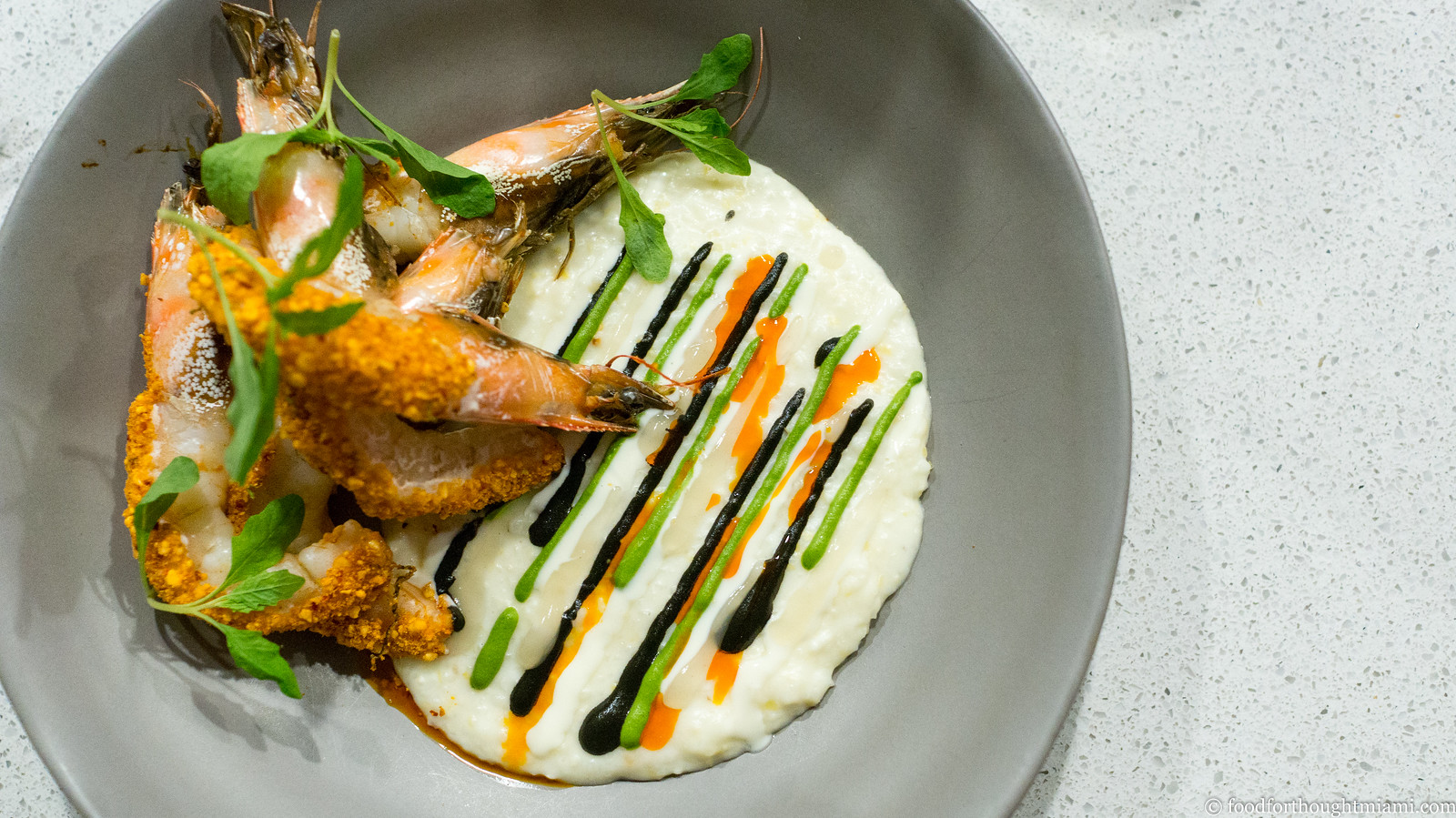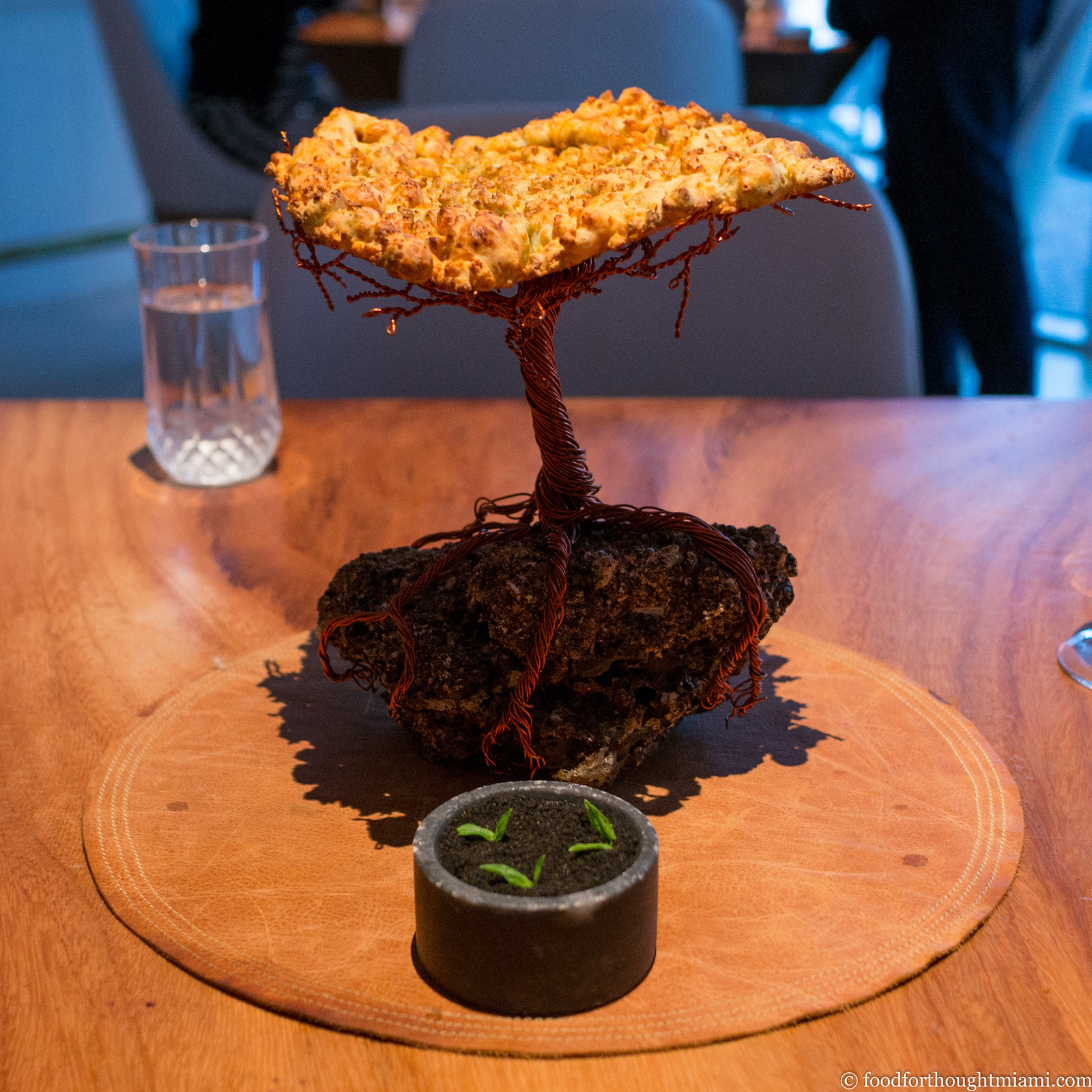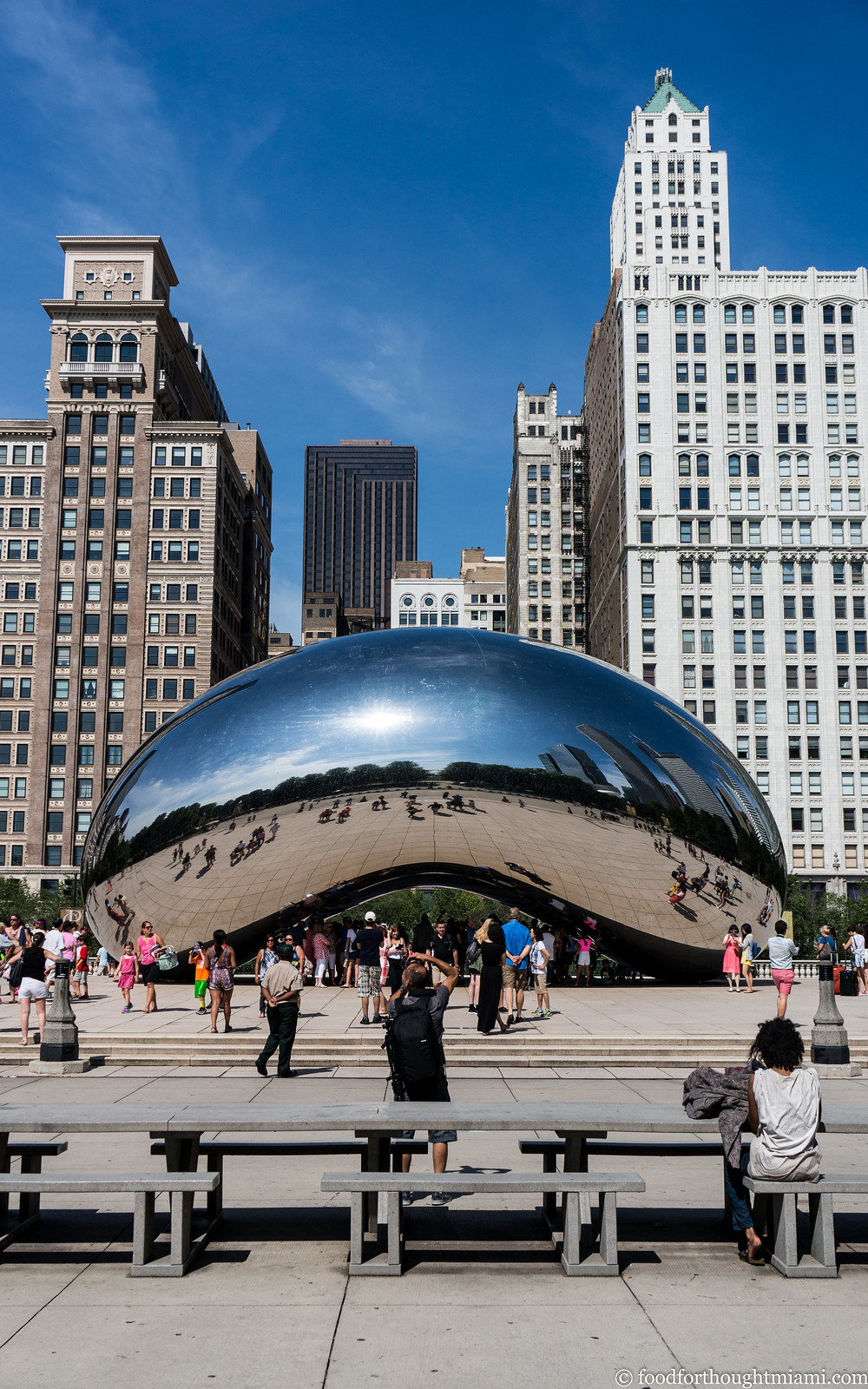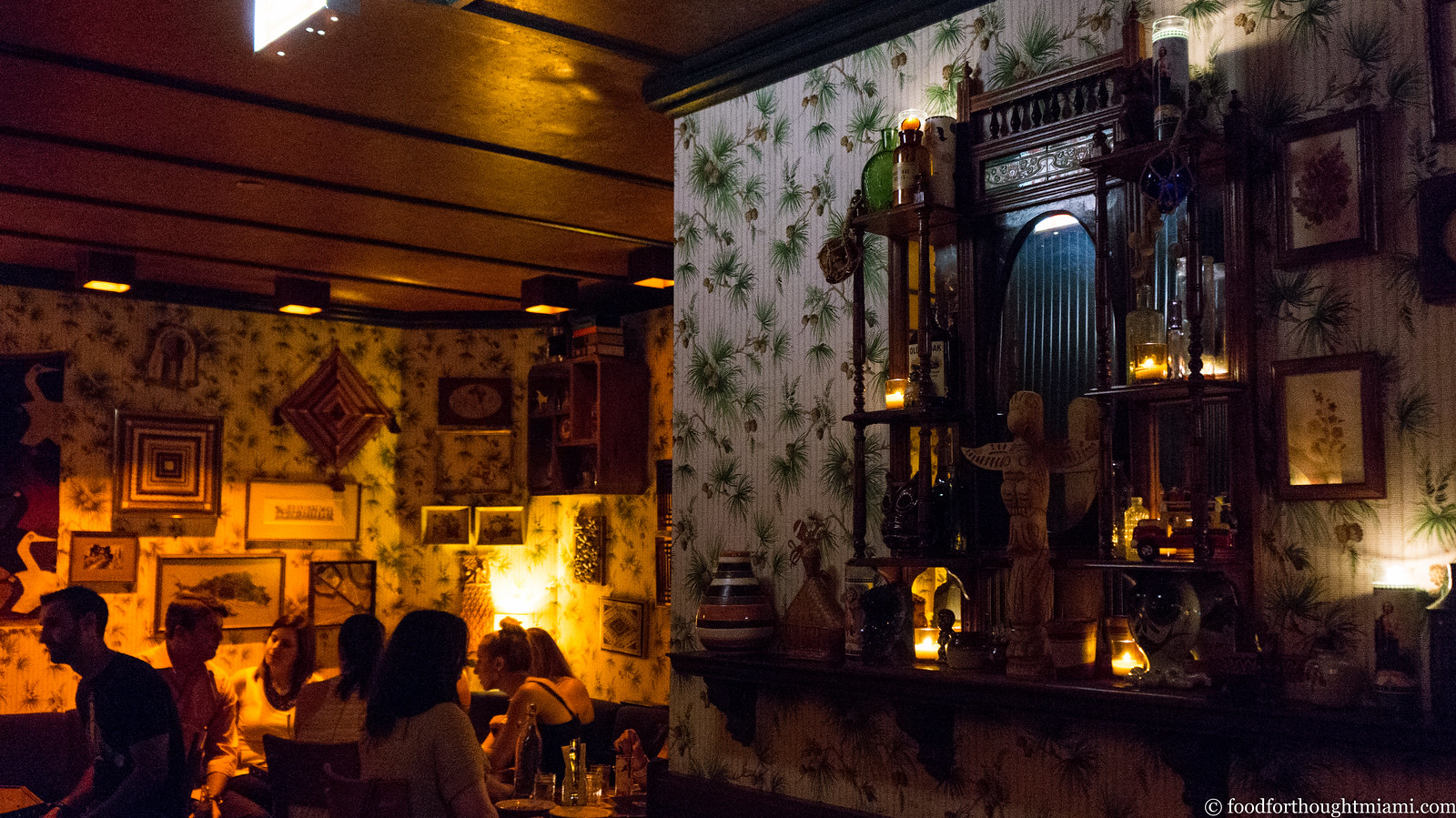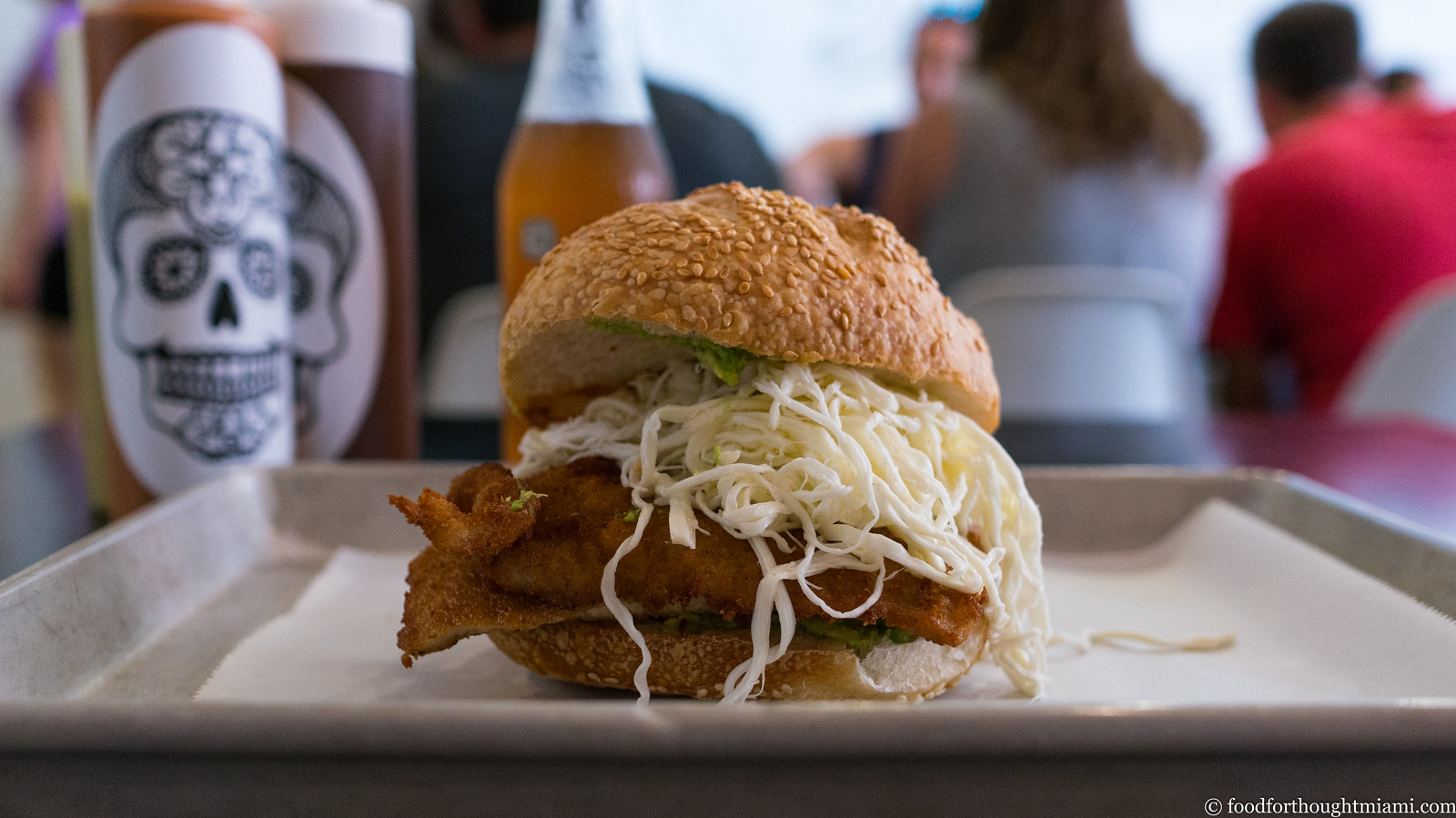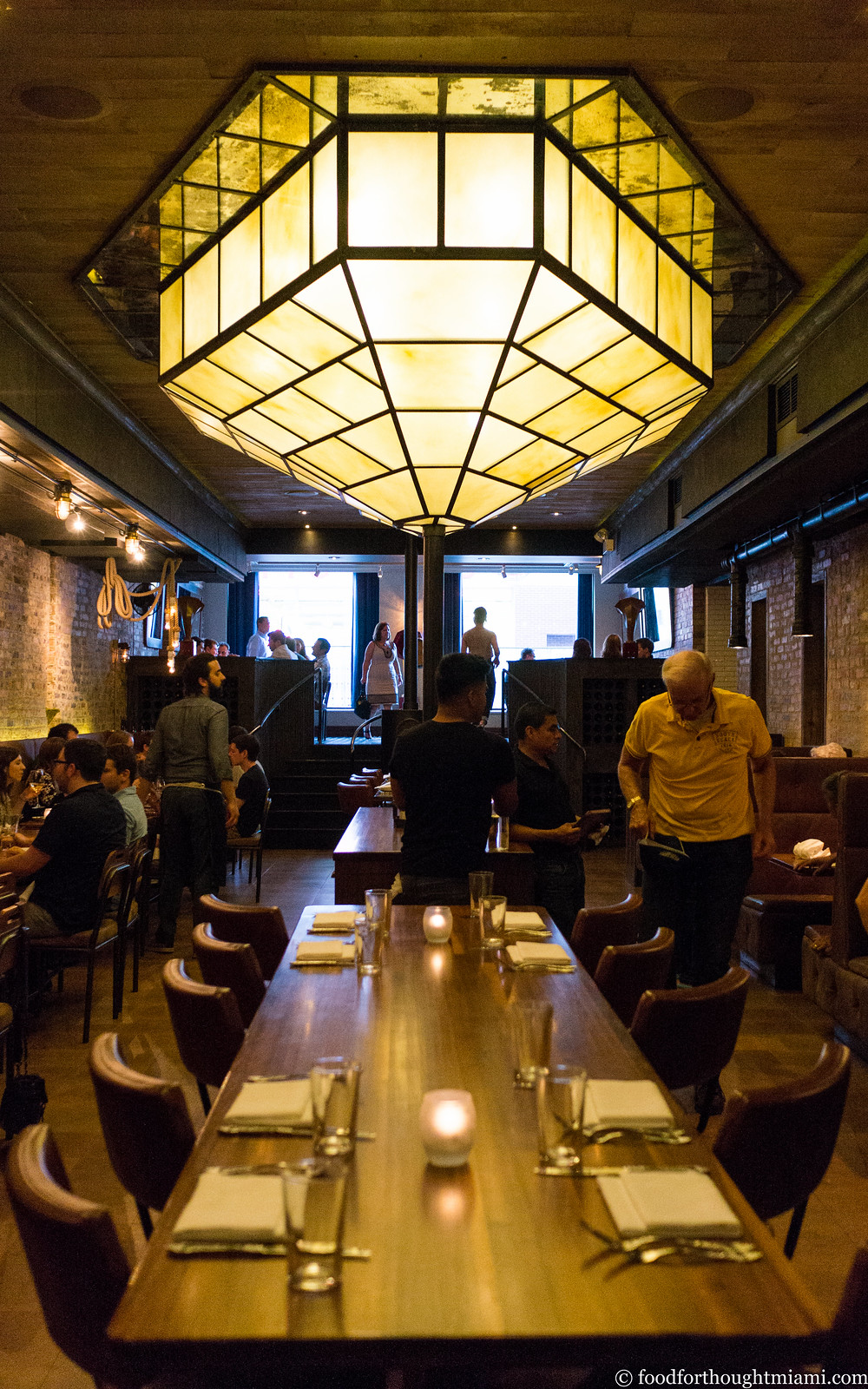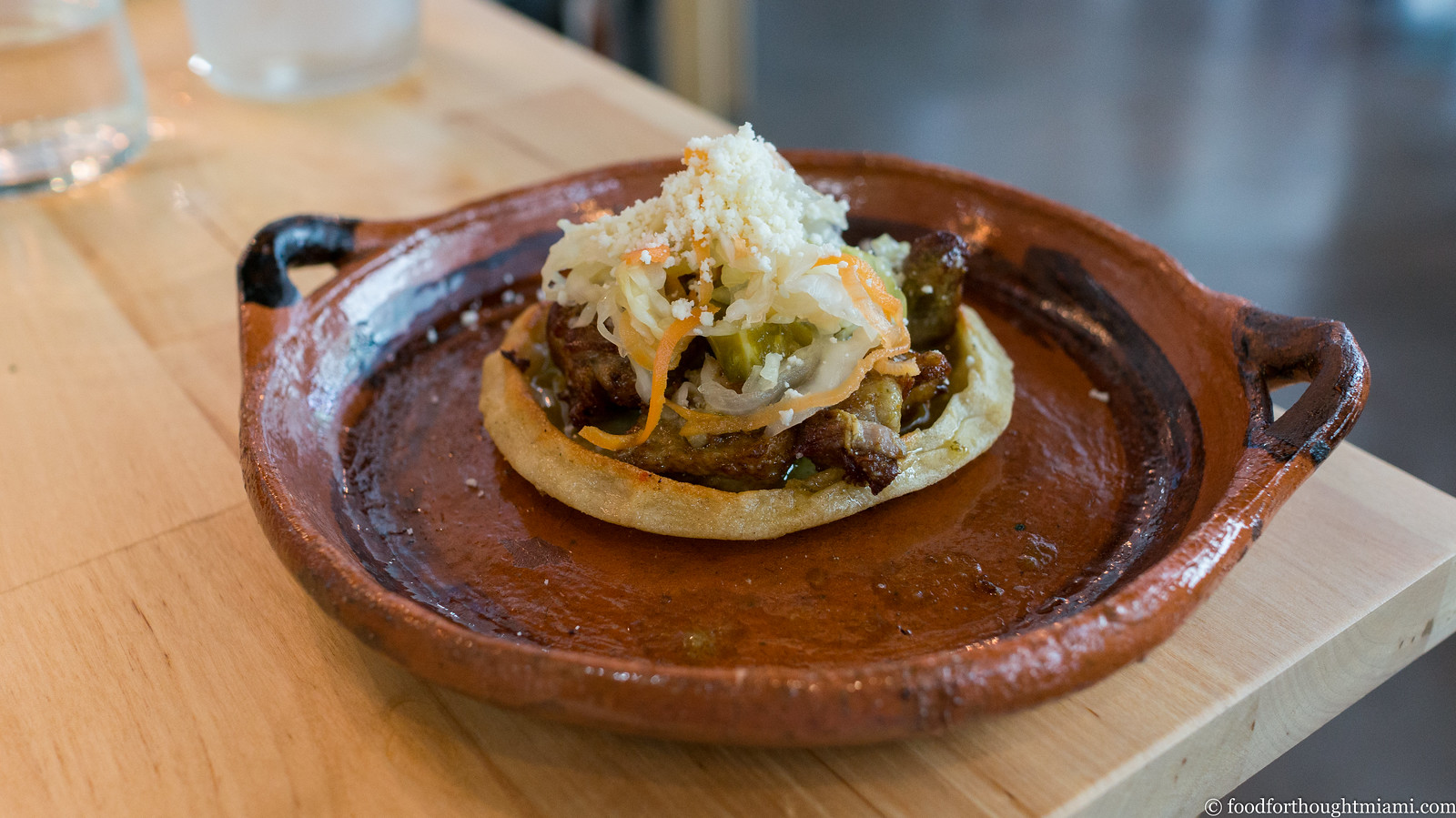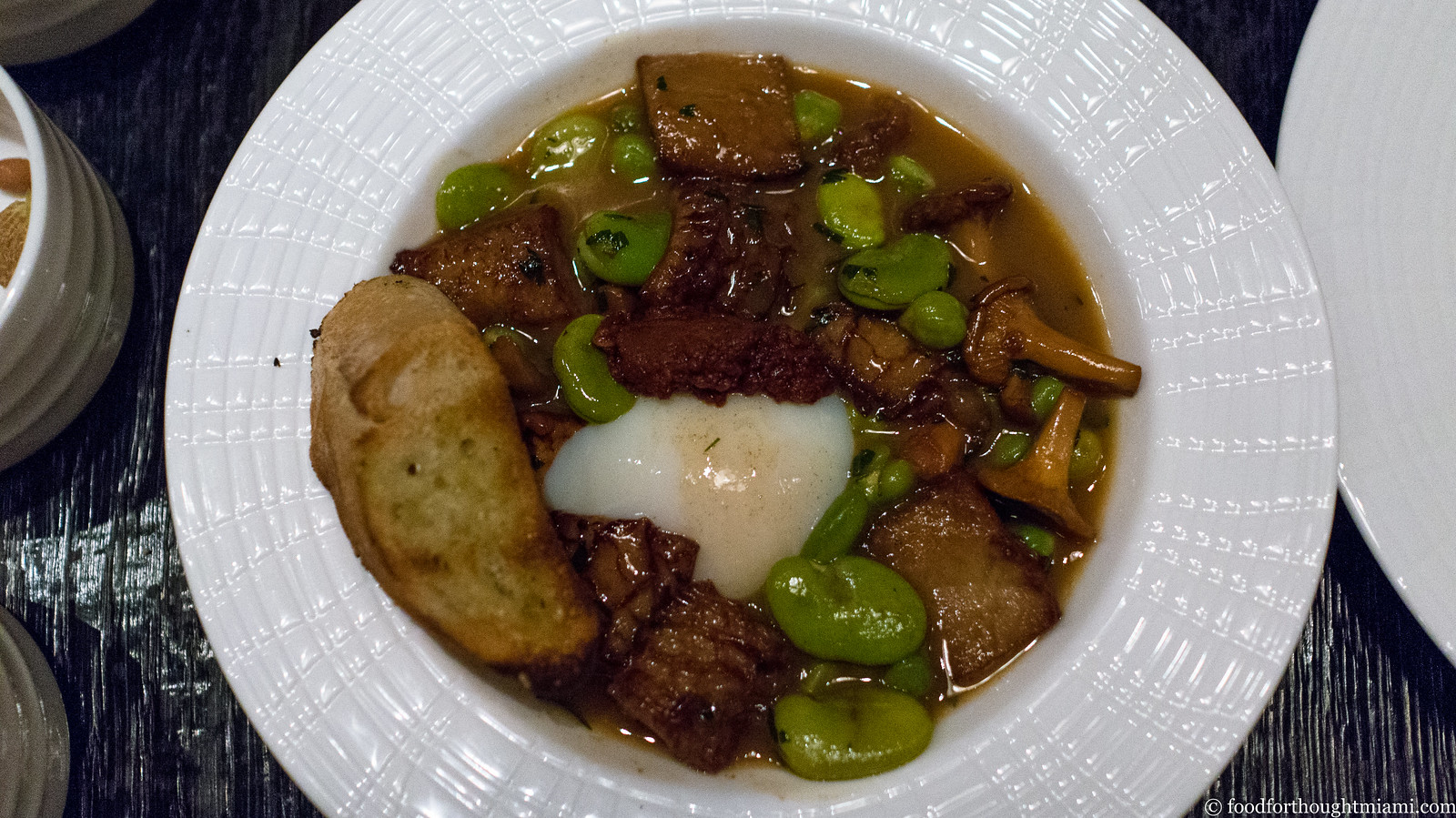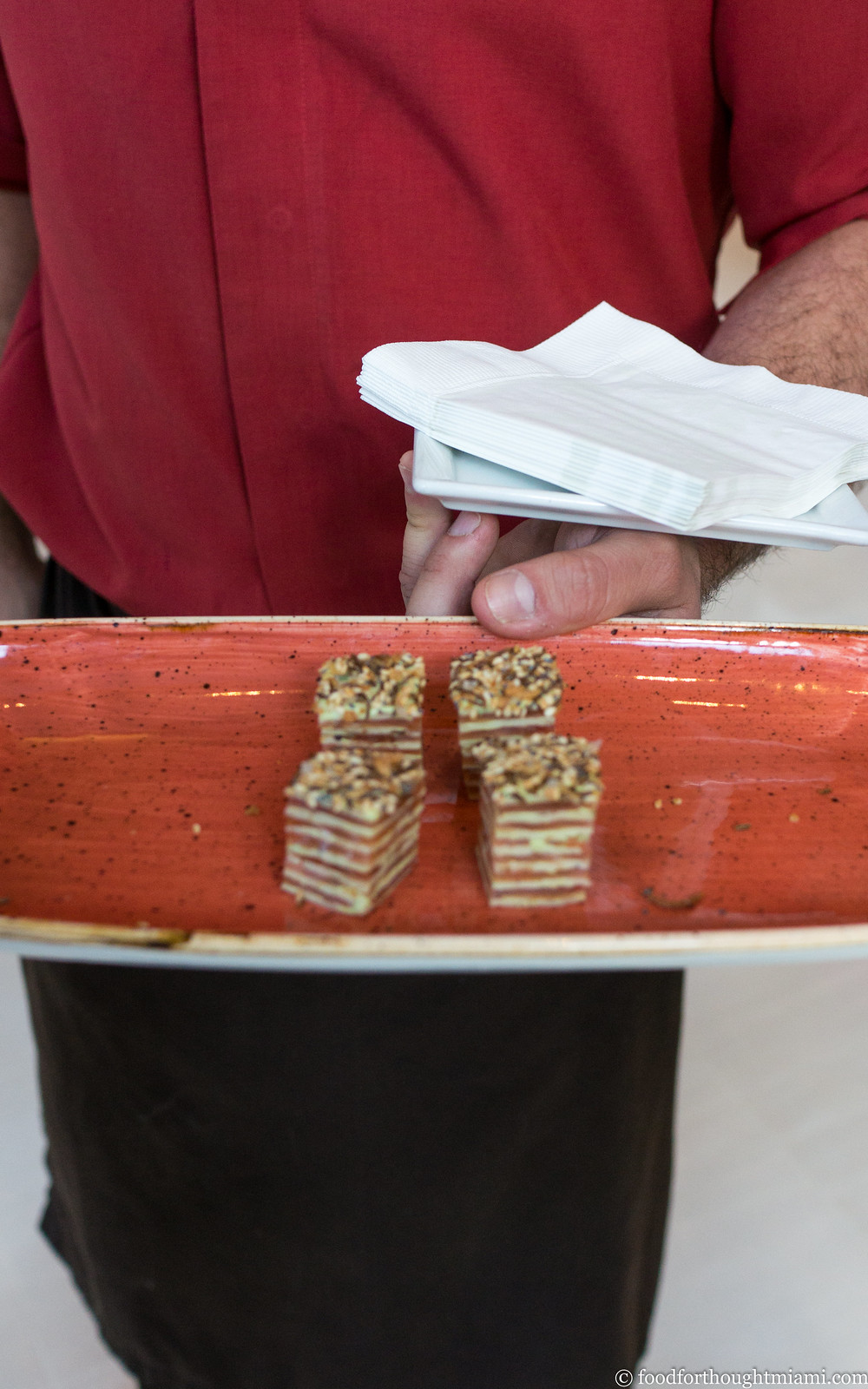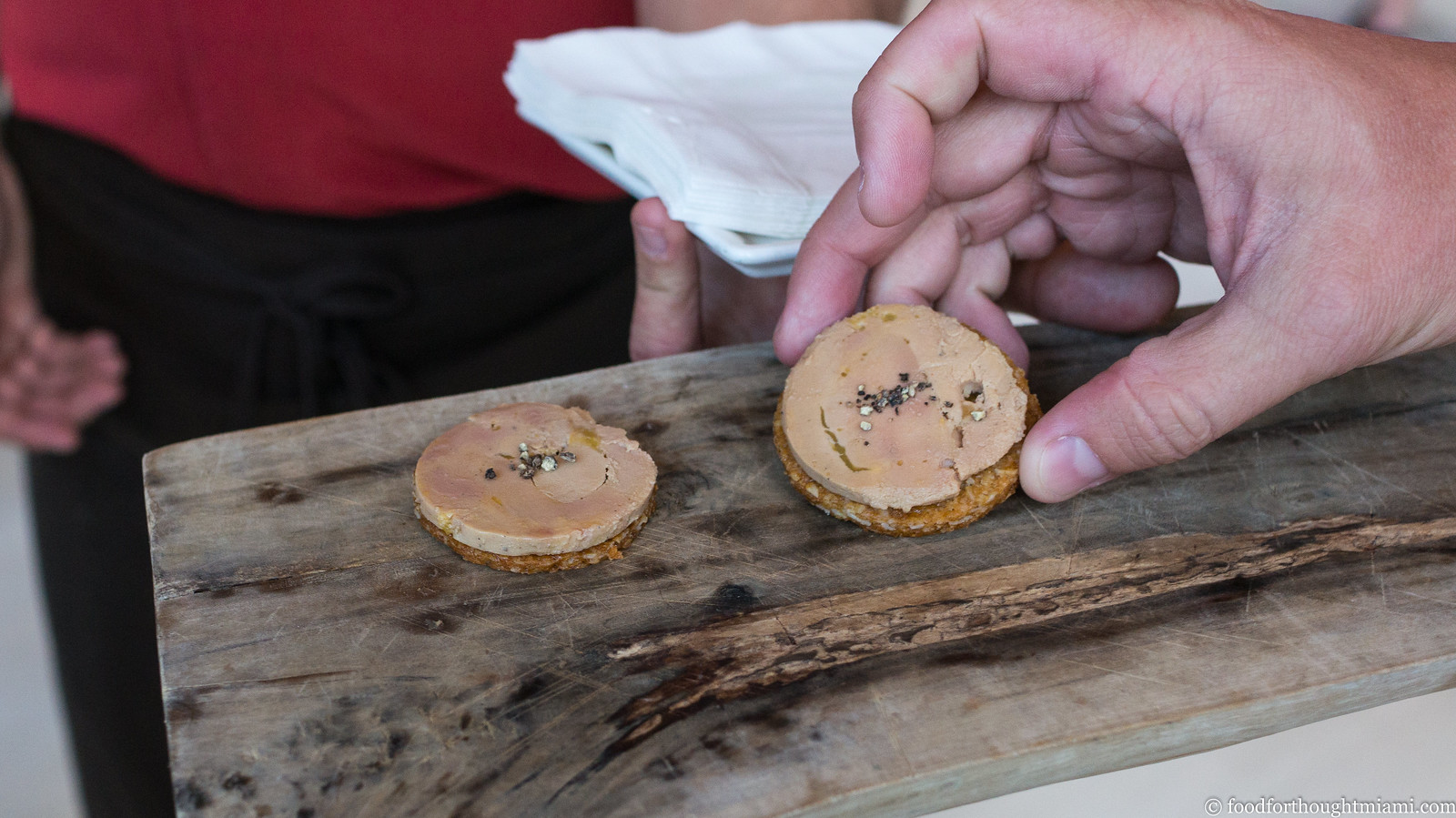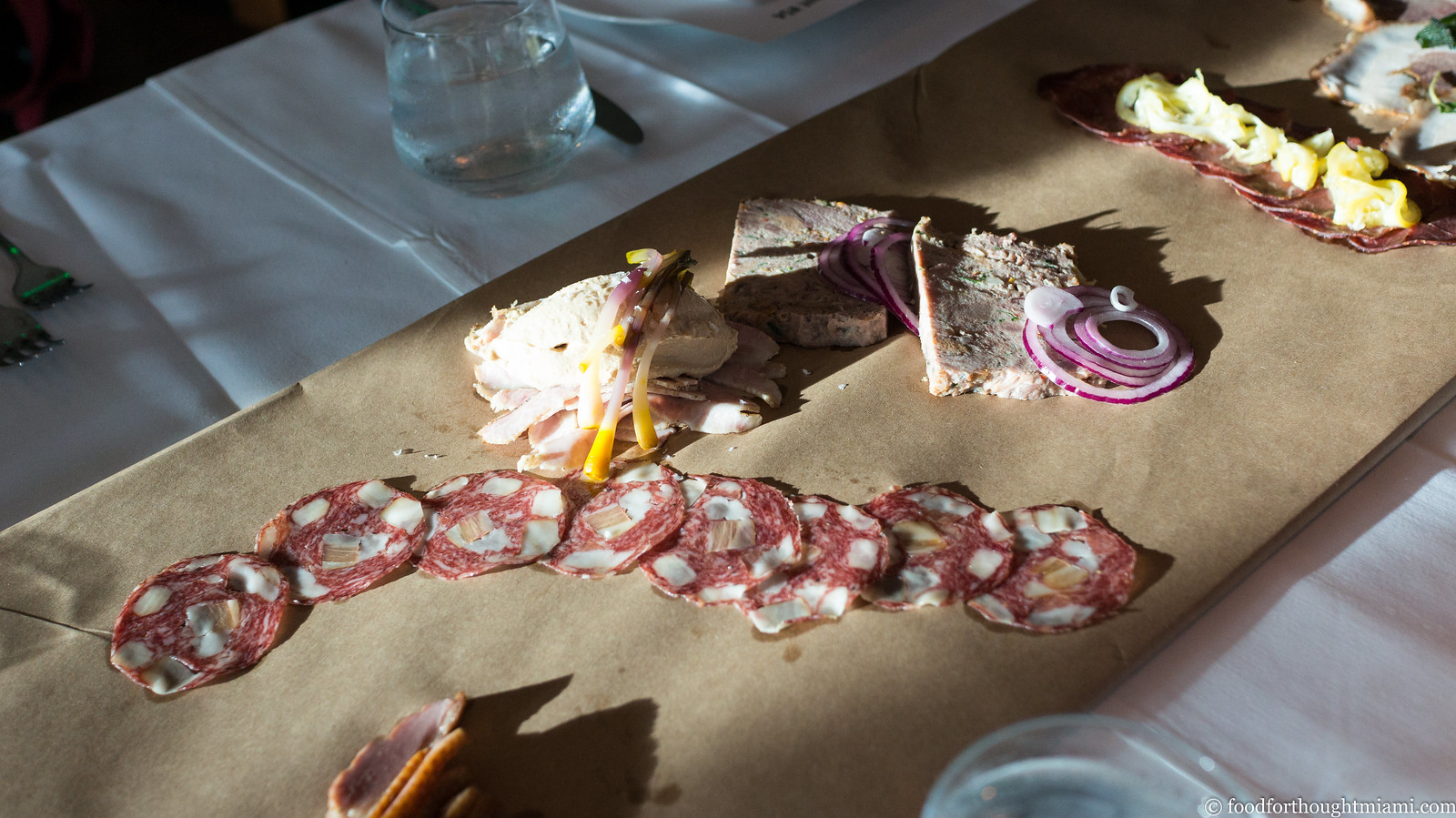Friday, October 16, 2015
best thing i ate last week: pasta "vongole" at Cobaya Seagrape
A bit behind schedule here, as it's already Friday, but better late than never. Last Tuesday we held our 56th Cobaya dinner, this time with chefs Jason Schaan and Tony Velazquez at Michelle Bernstein's Seagrape in the Thompson Hotel on Miami Beach. A full update will be coming shortly, but here let me just talk about my favorite dish of the night: their pasta vongole. This was no garden variety linguine and clam sauce. Here was hand rolled garganelli nestled among a couple different kinds of clams (manila clams and venus clams), batons of salsify and roasted mushrooms, a tangle of sea beans, with a generous knob of silky, oceanic uni butter mounted on top as it was served. It was a great mix of surf and earth, and the best thing I ate last week.
Monday, October 5, 2015
gastroDobo - 10.10.15 with Chefs Roel Alcudia and Jeremiah Bullfrog
In lieu of the "Best Thing I Ate Last Week" – because I didn't really eat anything all that great last week – let me take a moment to pitch something I look forward to eating. Chef Roel Alcudia, until very recently chef de cuisine at The Cypress Room, is teaming up with Jeremiah Bullfrog of the gastroPod, to do a pop-up dinner in Wynwood on Saturday October 10. Roel will be getting back to his roots with some Filipino style dishes – a preview menu hits on lots of classics: balut, lumpia, kinilaw, chicken adobo and more (hey guys, where's the sisig?).
Service will be a la carte style and you can ensure your spot by booking here (your $25 deposit will go towards your tab).
Thursday, October 1, 2015
best thing i ate last week: grilled carrots with aged gouda and buckwheat at Eating House
Somehow, I had let a year go by since my last visit to Eating House, Giorgio Rapicavoli's pop-up gone permanent on the northern edge of Coral Gables. That was dumb of me. This past weekend I grabbed a solo spot at the bar after both wife and daughter had abandoned me for the evening, and sampled as much as I could of the current menu. Some staples remain: the tomatoes with coconut ice and Vietnamese flavors, the chicken and "foi-ffles," the over-the-top pasta carbonara. But everything else around the edges is new – and very good.
Vegetable-focused dishes in particular are a strong suit, and of these, my favorite was a plate of grilled carrots, blanketed in soft curls of a powerfully rich five-year aged gouda cheese (it gets crystals like a good aged parmigiano-reggiano), dappled with crunchy buckwheat kernels, all resting atop a pillow of a creamy carrot-top pesto. I especially liked that the carrots were not annihilated, but maintained a not-quite-raw but still firm core – so you get both clean, vegetal snap and dark, sweet roasty caramel flavors. It was the best thing I ate last week.
Runners-up: the blistered shishito peppers showered with cured egg yolk and dry olive at Eating House; the flaky malawach bread (a Yemenite specialty) served with spicy hariff, grated tomatoes, feta cheese and hard boiled egg for brunch at 27 Restaurant (especially good when accompanied by a Miso Honey Cold Brew).
Monday, September 21, 2015
best thing i ate last week: schmaltz herring toast at Zak the Baker
It was the first thing I ate at Zak the Baker when the Wynwood café opened last May: a toasted slab of his fantastically crusty, naturally leavened multigrain bread, topped with slick, fatty brined schmaltz herring and pickled onions. On that first visit, it was paired with a 10 a.m. vodka shot which Zak rightfully insisted was an essential accompaniment.
This past Sunday morning, there was mercifully no hard liquor, but there was that same delicious fish, that same delicious bread, those same tart onions, though a pickle-infused aioli substituted for the creamy creme fraiche of that first visit. Still mighty good. And the best thing I ate last week. Pro tip: ZTB gets crazy busy with Sunday brunchers, but still keeps baker's hours, and opens at 7 a.m. If you can rouse yourself early, you may be able to squeeze in before the crowds.
Runner up: a classic from chef Michelle Bernstein's repertoire, on the menu at her Miami Beach restaurant, Seagrape: a delicately fried squash blossom stuffed with shrimp mousseline, served over a bed of creamy corn grits and dappled with a rich seafood nage.
Saturday, September 19, 2015
a message from the future
A couple weeks ago Eater Miami asked me, "What do you think the future of dining looks like?" Some of my comments ran yesterday along with responses from several other locals as part of a series of "Future Week" stories across the Eater network. It may not surprise you that I actually had a bit more to say on the subject. Here's an expanded version of my thoughts on the future of dining, particularly in South Florida.
There is already movement in this direction, and the political push for minimum wage increases plus the shortage of line cooks will create increasing pressure to even out front-of-house and back-of-house compensation. (Sooner or later the light bulb will go off that there's a connection between the low wages for kitchen employees and their scarcity). Putting service staff on salary without a tip credit will be a big shift, but possibly a necessary one.
On my last visits to the Bay Area, several places were either adding a "service charge" or doing "service included" bills (Comal and Ippuku in Berkeley, Camino in Oakland). There have been some interesting success stories, including a couple places that give long-term employees a small share of ownership. Just this week, Tom Colicchio announced he is going to a no-tip, price-inclusive-of-service program during lunch service at Craft. There have also been places that tried, and ultimately balked, at using all-inclusive, no-tip pricing (Aster in San Francisco comes to mind).
In Miami, anyway, we're already accustomed to seeing "gratuity added" (or not seeing it clearly marked on the bill, but still having it done!). It would make little difference to the diner if instead, it was "service included" that gets shared with BOH and FOH, but it would require a change in how the restaurants operate.
One arguable financial upside to making this shift for restaurateurs: it will mitigate the risk of wage violation lawsuits that often arise from asserted non-compliance with tip credit requirements. Perhaps not coincidentally, Colicchio's restaurants have twice been sued for wage violations – once back in 2008 (a case that was settled), and more recently this year in connection with 'wichCraft (he pointedly denies the latest allegations). These lawsuits can be high-stakes stuff: in 2008, Jean-Georges Vongerichten paid $1.75 million to settle wage claims; in 2009 Nobu paid $2.5 million for similar claims; in 2012, Mario Batali and Joe Bastianich's restaurants paid $5 million in a settlement.
See 1. Increasing wages will put even more pressure on thin margins; eventually the cost of dinner will have to go up.
See 1, 2. If the cost of labor is going up, and you have limited ability to raise prices, then you'll have to figure out how to get by with less employees. I expect there will be more "fast casual" type places, and that it will be increasingly difficult to successfully operate a moderately priced sit-down restaurant. Miami chef Alberto Cabrera recently made this shift, turning his Coral Gables restaurant Bread & Butter from a sit-down place into Little Bread, with counter service sandwiches and bowls, and I think it will prove to be a good move for him. Big picture, though, this bums me out, and I hope I'm wrong. Some of my favorite restaurants are the mid-range places where you can find interesting, ambitious food without it being a hundred dollar meal to pay for a million dollar build-out. I worry these will become an endangered species.
Everything can't be in Wynwood, South Beach or Brickell. And there are huge parts of Miami-Dade County with lots of population density, lower rents, and little restaurant competition other than chains, like Doral and Kendall. Closer to Miami's urban core, you're already seeing it happen in Edgewater (Mignonette) and the Upper East Side (Vagabond, Cena by Michy, Blue Collar, etc.), and I think the push northward up Biscayne Boulevard will continue. And maybe just a bit west too: Little Haiti?
Some of them may be great. They all won't be. And it may prove tough to fill so many big dining rooms, even if you''re a "celebrity chef." Just ask Fabio Vivani. Or Tony Mantuano. Or Geoffrey Zakarian. Or – hot off the presses – Masaharu Morimoto, who announced just yesterday that he is closing his restaurant in the Shelborne on South Beach after exactly a year. Or ....
1. Tipping may become a thing of the past.
There is already movement in this direction, and the political push for minimum wage increases plus the shortage of line cooks will create increasing pressure to even out front-of-house and back-of-house compensation. (Sooner or later the light bulb will go off that there's a connection between the low wages for kitchen employees and their scarcity). Putting service staff on salary without a tip credit will be a big shift, but possibly a necessary one.
On my last visits to the Bay Area, several places were either adding a "service charge" or doing "service included" bills (Comal and Ippuku in Berkeley, Camino in Oakland). There have been some interesting success stories, including a couple places that give long-term employees a small share of ownership. Just this week, Tom Colicchio announced he is going to a no-tip, price-inclusive-of-service program during lunch service at Craft. There have also been places that tried, and ultimately balked, at using all-inclusive, no-tip pricing (Aster in San Francisco comes to mind).
In Miami, anyway, we're already accustomed to seeing "gratuity added" (or not seeing it clearly marked on the bill, but still having it done!). It would make little difference to the diner if instead, it was "service included" that gets shared with BOH and FOH, but it would require a change in how the restaurants operate.
One arguable financial upside to making this shift for restaurateurs: it will mitigate the risk of wage violation lawsuits that often arise from asserted non-compliance with tip credit requirements. Perhaps not coincidentally, Colicchio's restaurants have twice been sued for wage violations – once back in 2008 (a case that was settled), and more recently this year in connection with 'wichCraft (he pointedly denies the latest allegations). These lawsuits can be high-stakes stuff: in 2008, Jean-Georges Vongerichten paid $1.75 million to settle wage claims; in 2009 Nobu paid $2.5 million for similar claims; in 2012, Mario Batali and Joe Bastianich's restaurants paid $5 million in a settlement.
2. Expensive restaurants will become even more expensive.
See 1. Increasing wages will put even more pressure on thin margins; eventually the cost of dinner will have to go up.
3. Lower end restaurants will look for ways to reduce staff.
See 1, 2. If the cost of labor is going up, and you have limited ability to raise prices, then you'll have to figure out how to get by with less employees. I expect there will be more "fast casual" type places, and that it will be increasingly difficult to successfully operate a moderately priced sit-down restaurant. Miami chef Alberto Cabrera recently made this shift, turning his Coral Gables restaurant Bread & Butter from a sit-down place into Little Bread, with counter service sandwiches and bowls, and I think it will prove to be a good move for him. Big picture, though, this bums me out, and I hope I'm wrong. Some of my favorite restaurants are the mid-range places where you can find interesting, ambitious food without it being a hundred dollar meal to pay for a million dollar build-out. I worry these will become an endangered species.
4. More independent restaurants in less trendy neighborhoods.
Everything can't be in Wynwood, South Beach or Brickell. And there are huge parts of Miami-Dade County with lots of population density, lower rents, and little restaurant competition other than chains, like Doral and Kendall. Closer to Miami's urban core, you're already seeing it happen in Edgewater (Mignonette) and the Upper East Side (Vagabond, Cena by Michy, Blue Collar, etc.), and I think the push northward up Biscayne Boulevard will continue. And maybe just a bit west too: Little Haiti?
5. 50% of the big-name chef restaurants that are opening in Miami won't be around after two years.
Some of them may be great. They all won't be. And it may prove tough to fill so many big dining rooms, even if you''re a "celebrity chef." Just ask Fabio Vivani. Or Tony Mantuano. Or Geoffrey Zakarian. Or – hot off the presses – Masaharu Morimoto, who announced just yesterday that he is closing his restaurant in the Shelborne on South Beach after exactly a year. Or ....
Monday, September 14, 2015
best thing i ate last week: chilaquiles verdes at Centro Taco
My first visit to Centro Taco was in late July, the day after they opened. And I was pretty excited by what I found: house-made tortillas rolled out at a workstation in the middle of the dining room, serving as vehicles for toppings which paid more heed to flavor than rigid authenticity. There were gator pibil tacos, duck carnitas tacos, and best of all, a gordita topped with Haitian style griots and pikliz that was the best thing I ate that week.
I finally got back for a second visit this past Saturday, when Chef Richard Hales features a brunch menu in much the same spirit. My favorite of the few things I tried was his version of chilaquiles. Fried tortilla shards are softened with salsa verde,[1] and serve as the base for a potato and pepper hash, poached egg, and some Proper Sausages chorizo verde flecked with green chiles and herbs. Slivered radishes, fresh cilantro, and yeah, some flower petals – because Richard's a sensitive vegan who likes flowers now – finish the dish. It was the best thing I ate last week.
(You can see all my pictures in this Centro Taco - Miami flickr set).
[1] In my mind anyway, there's a weird affinity between Mexican chilaquiles and Jewish matzo brei. But I suppose lots of food cultures use the same trick of refreshing stale breadstuffs with a soak in some flavorful liquid or egg: Spanish migas, French pain perdu.
Wednesday, September 9, 2015
best thing i ate last week: angel hair with crab, calabrian chili and lemon breadcrumbs at Proof
I don't often go to Italian restaurants, for reasons I've previously expressed. Put in less vulgar terms: it's not so easy to find it done much better than I can do it at home. So when I do go out for Italian, I go to a place like Proof Pizza & Pasta. The modest name belies the seriousness of the cooking here. The pizzas are very good, but the pastas are easily some of the best in town, rivaled only by Macchialina and perhaps Scarpetta (where I haven't been since Nina Compton left).
Case in point: their angel hair with crab. Angel hair is usually the most insipid and pointless of pastas, but here the noodles still have a substantial texture despite their diminutive width, making them an ideal vehicle for the sweet crabmeat. It all swims in an intense crustacean sauce somewhere between broth and bisque, with some Calabrian chiles for some zing, and lemon breadcrumbs for brightness and texture. It was the best thing I ate last week.
All the pastas at Proof are pretty consistently excellent, but I'd also suggest you not sleep on the bucatini with uni and roasted cauliflower, which was a new addition to the menu on my last visit.
(That picture is from about a year ago, though the dish remains the same; you can see all my pictures in this Proof Pizza & Pasta - Miami flickr set).
Runners up: this excellent house-made charcuterie board at Edge Steak and Bar in Brickell; this cured and oil-poached local tuna and kimchi reuben from Josh's Deli.
Tuesday, September 8, 2015
Coi - San Francisco
There's a passage in Daniel Patterson's book "Coi: Stories and Recipes" that I found almost painfully evocative. The chef was writing about his first restaurant in Sonoma, and the turning of the season from summer to fall:
It was when the rains came, and the tourists went away. The first year the bills piled up on the mantelpiece at home, one pile per week, carefully bound with a rubber band, the total owed marked on a Post-it on top. At first there were two, then four and later eight piles, sitting there as a constant reminder of our empty dining room. The rain cut off roads and flooded fields, seeping into our subterranean bedroom at home, filling it with the smell of damp concrete and mold. Subsequent years were never as bad as the first, but every fall after that, as the days shortened and our bank account dwindled, my heart broke a little as we dug in for an isolated, depressing winter. That was some time ago, but the scars still remain. Every year, even now, when I step outside and feel that the light has changed, that it is fall and that summer is gone, I fight down a rising panic. It will be all right, I tell myself, over and over, until eventually I believe it enough to keep going.Coi is one of the more unusual "cookbooks" I've read lately. It's not so much the format, which pairs a thoughtful one-page essay with each recipe, nor even the initially somewhat distracting decision to put all the ingredients and quantities for those recipes in a separate index at the back of the book. And while Patterson can wax seriously eloquent about what inspires his dishes and how to cook them, it wasn't entirely that either. What was so striking was his willingness to provide these personal and often brutally candid insights into the fears and frustrations of being a professional chef.
The restaurant business is a weird and particularly tough one that seems to be constantly teetering between success and failure, both on a macro and micro level. In a sea of competition, it's hard enough to figure out what's going to capture the dining audience's interest. Then you actually have to make it work. Even when you do, this year's hot-spot can quickly turn into next year's has-been. Get all the big things right, and you're still only as good as your last plate: some line cook screws up the seasoning or cooking time on one dish, or your server is having a lousy day, and a customer leaves with a bad impression that you may never have a second chance to remedy.
From reading his book and following his career, it's clear Patterson recognizes and, in his own way, embraces this dance on the edge. In the essay about his "beet rose," an almost absurdly labor-intensive dish in which slivers of roasted beet are assembled by hand to resemble the petals of a rose, then paired with an aerated yogurt and rose petal granita, he describes it like this:
When a dish is right, there is synchronicity between form and substance, idea and execution. This is a dish that was meant to be challenging to make, impractical to reproduce. There is something about its unreasonableness which makes it more impactful. For it to work, everything has to be perfect. ... But I came to love it most for what it represented to me: intuitive, handmade cooking. Each rose is a little different, and I can pick out who made which one every night. The seasoning is finely tuned, wobbling on the edge of sweet and savory, always close to tumbling into failure.That sounds a little crazy, but yeah, I'd like to experience that. Because as good a writer as he is, Patterson is pretty universally recognized to be an even better chef. And yet I'd never paid a visit to the restaurant from which the book takes its name. My travels to the West Coast are almost always with family, which means my opportunities to do tasting menus are limited. And other, shinier objects always seemed to beckon. Then a month ago, Patterson announced that he was stepping down as executive chef at Coi and handing over the reigns to chef Matthew Kirkley in January. It was a surprising announcement: first, because Patterson's work at Coi has been so highly regarded, but even more so because it has been so definitively Patterson's restaurant, and his style of cooking is so personal, that the two seemed inseparable.[1]
We already had a trip to San Francisco coming up. So this would likely be the last chance, for the foreseeable future anyway, to catch Patterson in the kitchen. I re-jiggered the agenda, talked the family into doing a tasting menu dinner,[2] and booked a reservation at Coi. When they asked me what kind of restaurant it is, I wasn't sure exactly how to answer. What I knew is that it's a tasting menu format (but much more restrained than the 20+ course bacchanals like Saison); that it's got some locavore / forager sensibilities, but is not wedded to them; and that the cooking uses, but does not seem defined by, contemporary techniques and processes. This undefinability is also something of which Patterson is acutely self-aware:
When it comes to what a marketing wonk would call 'brand clarity,' we don't do ourselves any favors. ... When someone asks, 'What's the food like?' the best thing I can come up with is, 'Um, hopefully delicious,' my voice rising at the end in a note of uncertainty.Well, let's see.
For this farewell tour of sorts, Patterson has seeded the menu with several "greatest hits," and his "California Bowl" is one of those. It's really just an elevated version of chips and dip using some of the basic tropes of California hippie cuisine: brown rice, avocado and sprouts. But those chips (made from rice cooked down to a paste, dehydrated, then fried like chicharrones) are light and airy and have a tingle of spice, the avocado is whipped until soft as a cloud, and zinging with lime, the tiny greens have bright, fresh, intense flavors.
(You can see all my pictures from the dinner in this Coi - San Francisco flickr set).
(continued ...)
Monday, August 31, 2015
best thing i ate last week: new england clam chowder at Mignonette
I'm still working on getting caught up from our vacation, but in the interest of not falling too far behind, let's talk about this past week. Actually, it mostly consisted of lots of home cooking, which is not a bad thing; but not as good as this New England clam chowder, Sunday's "CBGB" (Chowder, Bisque or GumBo) at Mignonette.
First things first. It's the right kind of clam chowder: New England style, lashed with cream, not that perverse red abomination that some tasteless troglodytes prefer. James Beard had it right, describing "that rather horrendous soup called Manhattan clam chowder" as resembling "a vegetable soup that accidentally had some clams dumped into it."
But even better: it's not so dense with cream that you can't taste anything else. The creamy broth is cut with vinegar and cayenne (I always dash my chowder with hot sauce, but Mignonette chef Bobby Frank saves me the trouble), brightening and lightening it so you can taste the clams, bacon and potatoes bobbing within. A couple plump steamed middlenecks are floated on top just before it's served.
It was the highlight of a Sunday brunch that also included some nice briny oysters, a crudo of cobia tweaked with tart huckleberry juice and diced jalapeño, and a hearty eggs benedict with shrimp and sherry cayenne aioli.
(You can see all my pictures from brunch – and more – in this Mignonette - Miami (Edgewater) flickr set).
First things first. It's the right kind of clam chowder: New England style, lashed with cream, not that perverse red abomination that some tasteless troglodytes prefer. James Beard had it right, describing "that rather horrendous soup called Manhattan clam chowder" as resembling "a vegetable soup that accidentally had some clams dumped into it."
But even better: it's not so dense with cream that you can't taste anything else. The creamy broth is cut with vinegar and cayenne (I always dash my chowder with hot sauce, but Mignonette chef Bobby Frank saves me the trouble), brightening and lightening it so you can taste the clams, bacon and potatoes bobbing within. A couple plump steamed middlenecks are floated on top just before it's served.
It was the highlight of a Sunday brunch that also included some nice briny oysters, a crudo of cobia tweaked with tart huckleberry juice and diced jalapeño, and a hearty eggs benedict with shrimp and sherry cayenne aioli.
(You can see all my pictures from brunch – and more – in this Mignonette - Miami (Edgewater) flickr set).
Thursday, August 27, 2015
best thing i ate last week (8/2-8/9): celtuce, just dug potatoes, comté, burnt hay, tarragon at Coi
A vacation has taken me off the regular posting cycle, but after two weeks tooling around the Bay Area (including moving Frod Jr. into U.C. Berkeley), I'm home in Miami and ready to get caught up. That means circling back to the first day of our trip: a visit to Coi, which I squeezed into the schedule on account of Chef Daniel Patterson's announcement that he will be stepping down as executive chef in January. (Patterson simultaneously announced that Matthew Kirkley, last at L2O in Chicago, will be taking over the kitchen. In a curious coincidence, I caught Kirkley at L2O only a couple months before it closed last year. That was an excellent meal, and while it's disappointing to see Patterson step away from cooking at Coi, I expect good things are in store.)
(You can see all my pictures from the dinner in this Coi - San Francisco flickr set).
The primary ingredient in this dish is celtuce, featured both in thickly sliced discs and thin ribbons of its stalk. It has the hearty snap of a broccoli stem, and a delicately bittersweet flavor somewhere in the neighborhood of lettuce, celery and asparagus. Freshly dug potatoes are cooked until just tender, and crowned with caps of nutty, buttery melted comté cheese. These sit over an oil blackened with powdered burnt hay. Those black and charred aromas are brought back to green and fresh by a few wispy leaves of tarragon.
"Coi" is an archaic French word meaning "quiet," and Patterson's cooking voice can be quiet, subtle, understated. Sometimes you have to listen closely. If you do so, in this dish maybe you'll hear something that sounds like a field of grass blown by the wind, with all these variations on the vegetal tastes of the pasture.
Runner up: the stone fruit curry with black lime cod, green beans and blueberries at Al's Place, just named the Best New Restaurant of 2015 by Bon Appetit magazine. Like many of chef Aaron London's dishes at Al's Place, the combination of ingredients sounds absolutely implausible, and tastes absolutely delicious.
Wednesday, August 5, 2015
Alter - Miami (Wynwood)
About four years ago I came across a blog called "The Power of a Passion." It was the product of a young chef who had recently moved to Miami after working in Chicago – first a brief tour of duty at Alinea, then a year and a half at L2O during chef Laurent Gras' tenure, followed by a stint as pastry sous chef at Boka, then a move to executive sous chef at Epic. He'd come here to take a position as sous chef at Azul restaurant, where Chef Joel Huff had recently been put in place as executive chef.
The author was Bradley Kilgore. And it may have been those blog posts as much as anything that prompted our interest in doing a Cobaya dinner at Azul – one which ended up being filmed by Andrew Zimmern and featured in an episode of Bizarre Foods. Anyone who was at that dinner – which included at least one course that was Brad's creation – could sense that Kilgore had some real talent.[1]
Several months later we made a return visit to Azul; Huff was gone and the kitchen was now in the hands of Kilgore and chef de cuisine Jacob Anaya. We gave Brad free reign and he put together a sensational meal. His "anatomy of a suckling pig" remains one of the most epic pork-fests I've ever experienced.
Shortly after, Kilgore got an opportunity to run his own spot, and opened Exit 1 in Key Biscayne. But for a lot of reasons that didn't work out. The location was far from ideal, the owners were not exactly veteran operators,[2] and while Brad could cook, he may have been a bit inexperienced himself in all of the other components involved in running a restaurant. That didn't last long, but a better opportunity rolled around when he took over the chef de cuisine position at J&G Grill in Bal Harbour. Here was an established high-end restaurant in the empire of one of the most successful restaurateurs in the world (Jean-Georges Vongerichten), with the bonus of getting to team up with one of Miami's brightest stars: pastry chef Antonio Bachour. Sure, Brad was mostly executing Jean-Georges' best hits, but he also got a little bit of leash to do his own thing too, including some really exceptional on-request tasting menus.
So I was a bit surprised when last November, after a little more than a year at J&G, Kilgore announced that he was leaving to open his own restaurant. As talented as I knew him to be, I'll confess I was concerned that it was too soon. The last thing I wanted – for him, and frankly, for myself as someone who really enjoyed eating his food – was another exit like Exit 1.
I was wrong. He was ready. And his new restaurant – Alter, in Wynwood, which opened in late May – is already one of the best restaurants in Miami.[3]
(You can see all my pictures in this Alter - Miami (Wynwood) flickr set; pictured at top, a pre-dessert of assorted local tropical fruits in a crisp candy shell, served on an inverted woven palm frond basket).
The space, in the burgeoning Wynwood arts district,[4] has a minimalist, industrial feel: the cinder block walls are bare, the ductwork is exposed, the primary decoration is an abstract squiggle of hot pink neon hanging over the liquor shelf that separates the open kitchen from the dining room. The dark-stained wood tables seat about forty, with a small extra seating area outside if the temperatures ever drop. The room can get too warm when it's crowded and too loud when the music's cranked up, both of which are frequent occurrences.
The menu is nearly as spare as the decor. There are usually about eight appetizers and a comparable number of main courses; a five-course tasting menu ($65) is composed from the kitchen's choice of several of those items, some in shrunken-down portions, and is both a solid value and a particularly smart option for a first visit.
Lots of places have fish tartare on their menus these days. Nobody has one like this. Multi-hued batons of green mango and various radishes form a haystack on top of precisely diced fish, the exact species of which is dictated by whatever is local and fresh. There are celery leaves,[5] there's dried soy, there's yuzu kosho, there's black lime zested over the top. It's simultaneously spicy, citrusy, smoky, green, and fresh, as the flavors ping-pong between suggestions of a Thai pok-pok salad and a Peruvian ceviche and other things entirely.
A "signature dish" can be both blessing and curse. It helps define a style – and bring customers in – but can also be a sort of trap, something that can never come off the menu. Alter's soft egg may be its signature dish, and I'm sure it's much too early for Brad to be worried about golden handcuffs.[6] A fluffy, brûléed scallop mousse, bearing just a subtle whiff of the ocean (turn up the volume with an optional dollop of Florida caviar), blankets a runny-yolked, soft-cooked egg hidden within. Also suspended underneath the surface are truffle pearls and a crackly shard of gruyere cheese, like those crusty bits on the side of the bowl that are maybe the best thing about French onion soup.
As signatures go, this is a fitting one for the cooking at Alter. The dish – like much of Brad's work – is a deftly executed balancing act between delicate subtlety and outright indulgence, earth and ocean, creamy and rich without being heavy and cloying. It also displays another thing I see often in Brad's cooking: the incorporation of dessert techniques into savory dishes, what with the mousse and the brûlée, inverting the past decade's trend of incorporating savory elements into desserts. Pro tip: if you're getting the egg, you really also need to get the "bread & beurre," a tender-crumbed miniature loaf crusted with sumac and dill seed, and served with whipped, shoyu-bolstered "umami butter." The bread is delicious on its own, but as a tool for getting every last bit of the egg, it is particularly effective.
Summer squash is often among the most nebbish of vegetables. Not here. Zucchini and yellow squashes are cooked just enough to temper their bitter, raw edge, but not so much as to turn watery and slimy. A green circle of an herbaceous, dill-infused purée serves as the base for their arrangement, which is interspersed with dabs of tart, creamy lemon curd.[7] Crumbles of soft feta cheese, a touch of citron vinaigrette, a tangle of crisp, fresh greens and some crunchy puffed wild rice complete the dish. It works a magical transformation on the squash, like a sexy librarian taking off her glasses and letting down her hair.
(continued ...)
Monday, August 3, 2015
best thing i ate last week: cape canaveral prawns at Alter
I found another favorite dish on my most recent visit to Alter this weekend: the tajin-crusted Cape Canaveral prawns, strewn over a bed of creamy corn grits lashed with stripes of mole verde, lime crema, and huitlacoche. It's a beautiful combination – like a next-generation Mexican shrimp 'n' grits – but what really elevates it is the quality of those prawns, tender and juicy underneath their chile and citrus coating, their heads bursting with oceanic goodness when chewed or squeezed. I hope to be posting a more thorough review of Alter soon. In the meantime, you can see pictures from a few meals in this Alter - Miami (Wynwood) flickr set.
Runner-up: the "Amazon's Tree of Life" at Juan Manuel Barrientos' Miami branch of El Cielo, a really stunning presentation (so much so I had to include a picture below) and also a delicious, warm, nubby, cheesy bread, reminiscent of Colombian pan de bono, with a dipping sauce of roasted vegetables and squid ink. (You can see all my pictures from the dinner in this El Cielo - Miami flickr set).
Tuesday, July 28, 2015
a weekend of eating (and other things) in Chicago
The idea was to break up the long hot summer by spending the weekend someplace cooler than Miami. Of course, our visit to Chicago coincided with a heatwave that brought 90 degree temperatures right along with us. So that part didn't go as planned.
My last brief visit to Chicago focused mostly on high-end dining – Alinea (pictures here) and the now-closed L2O (pictures here), though I also managed to squeeze into a seat at Au Cheval (pictures here) and snag one of their awesome burgers. But this trip was planned on fairly short notice, too late to book seats at a couple other places high on my to-do list: Grace and 42 Grams in particular.
So the question was, where to go in Chicago where we could book a table on about a week's notice?[1] I aimed a bit lower and made reservations at a couple newer additions to Chicago's dining constellation – Salero and Momotaro – as well as a place I've been hoping to try for a couple years, Trenchermen.
Other than the weather, it all worked out pretty well. Here's a brief travelogue of where we went and what we did.
Our very first stop was at the Broken Shaker (see all my Broken Shaker pics here), a newly opened Chicago outpost of Miami's craft cocktail bar in the Freehand Hotel. I may have brought the Miami weather with me, but the Bar Lab boys, Elad Zvi and Gabriel Orta, seem to have brought all the rest of the Magic City to the Windy City.[2] They've done an uncanny job of capturing the look and feel of the original bar in the old 1930's era Miami Beach Indian Creek Hotel. They get the drinks right too, with some Miami staples (Cocoa Puff Old Fashioned) mixed in with some Chicago-inspired cocktails. A Devonshire Fizz, with Rare Tea blood orange scented green tea, Campari, grapefruit soda, vermouth and Milagro tequila, took the edge off a steamy Chicago afternoon. We even ran into Elad at the bar, a day before he headed to New Orleans for Tales of the Cocktail and picked up a well-deserved award for Best American Hotel Bar for Shaker Miami.
Broken Shaker Chicago
19 East Ohio Street, Chicago, Illinois 312.940.3699
From there, we headed to dinner at Salero (see all my Salero pics here), a Spanish restaurant which opened about a year ago in the West Loop, which is becoming Chicago's restaurant row. The chef is Ashlee Aubin, an alumnus of (now-closed) Zealous and Alinea who also runs the kitchen at Wood. At Salero, Aubin mixes old and new, with lots of Basque influences in particular on display.
Though Spanish often means tapas, Salero's menu eschews the now-ubiquitous "small plates" format for more traditional appetizers ("entradas") and entrées ("platos fuertes"). Still, there is also a bar menu of pintxos (the Basque tapas equivalent) which, if you ask nicely, you can also avail yourself of in the dining room. It was from there that we ordered a couple "Gildas," a simple and wonderful pintxo of anchovies, manzanilla olives and guindilla peppers found throughout San Sebastian and Bilbao.[3] Also from the pintxos menu, a sampling of Spain's outstanding "conservas," or canned seafood products: berberechos (cockles), served simply with bread, butter and lemon, and still tasting like they were straight from the sea.
A variation on calçots looked to the Catalan instead of the Basque country for inspiration; the brick-red, mildly spicy romesco sauce was right on target, but the grilled spring onions were all crispy greens and none of the tender, sweet whites that are the highlight of the traditional dish.[4] A rabbit terrine looked somewhat sloppy and disheveled, but I would have ordered anything that came with the excellent cheese-stuffed, tempura-fried padron peppers that accompanied it. And I loved Salero's modernized version of callos a la madrileña, which was the Best Thing I Ate Last Week (last week).
Salero
621 W. Randolph Street, Chicago, Illinois 312.466.1000

The following morning we headed up to Lincoln Park, where the Green City Market hosts a Saturday farmers market. We grabbed a pint of some Michigan berries from Mick Klug Farm and a buttermilk doughnut from the Doughnut Vault truck parked along the street and had our breakfast on a park bench.
Just down the street is the Chicago History Museum, which had a fantastic exhibit of photos by Vivian Maier, a nanny for several Chicago families who in her spare time took pictures all around the city during the 1950's through 1970's. This was really a stunning exhibit with an odd backstory. Maier apparently didn't show her photographs to anyone during her lifetime, and at some point in her life, a storage locker with thousands of negatives was auctioned off after being seized by a landlord. In 2007 the negatives were discovered in a thrift auction house and finally made their way to the public eye.[5]
We wound up back in the West Loop for lunch, and after poking our noses into Stephanie Izard's Little Goat Diner (one hour wait) and Au Cheval (three hour wait!), I grabbed a sandwich at Cemitas Puebla instead. I'd never had a proper cemita before and my expectations were high – perhaps too high. I went with the milanesa, and it was a good, satisfying $8 lunch, but nothing that changed my life in any meaningful way. Nice crispy, juicy pork loin, on a nice puffy, crusty-shelled roll, but it had too much cheese, not enough avocado, and barely a whisper of any chipotle sauce. I doctored it with the tableside salsas, but it wasn't enough to make any magic.
Cemitas Puebla
817 West Fulton Market, Chicago, Illinois 312.455.9200

For dinner, we headed over to Wicker Park, past the teeming hordes filling the outdoor patio and stuffing their faces with tacos at Big Star, and around the corner to the somewhat more sedate Trenchermen (see all my Trenchermen pictures here). The entrance looks like a Victorian scientist's cabinet of curiosities, with terrariums mounted on the wall and shelves stuffed with odd knick-knacks. Down a half-flight of stairs, you'll find yourself in the lengthy bar, which occupies a space that used to be a Russian bathhouse and still feels a bit like it, with white subway tiles lining the walls of the subterranean space. The dining room occupies a parallel room dominated by huge octagonal lights that look like they were poached from a Frank Lloyd Wright project.
The food, from Chef Pat Sheerin,[6] is equally eccentric, often referencing multiple cuisines at once, even on the same plate. Notwithstanding the heartiness suggested by the restaurant's name, most dishes tread pretty lightly. The menu is divided into sections for cold and warm starters and then mains, but a four-course prix fixe option lets you choose two starters, a main and a dessert, which is about the right amount of food.
Salt and pepper squid, served over a salad of cubed eggplant and cucumber with spicy chiles, felt Asian and Middle Eastern at the time, sichuan peppercorn bringing that tingly "ma la" sensation, cumin vinaigrette adding that warm B.O. funk. That may not be the most appetizing description, but it was a delicious dish. A plate of grilled carrots paired with English pea falafel balls and an orange and olive oil "jam" also tasted like it had blown through the Mediterranean on its way to the table. A salad of kale and pickled escabeche vegetables napped with an avocado goddess dressing and sprinkled with toasted pumpkin seeds felt appropriately virtuous.
If Trenchermen has a signature dish, it may be the "pickle tots" – a mash-up of tater tots and fried pickles, served with a hot pink yogurt infused with dehydrated red onion, and ribbons of cured and smoked chicken "bresaola" (you can watch the Sheerin brothers prepare the dish here). I can see why they'd have trouble taking it off the menu – it's a great dish, simultaneously contemporary and nostalgic.
While you can go meaty at Trenchermen, with a double burger, beef shoulder, or leg of lamb, it's also a vegetarian-friendly place, with not one but two plant-based main course options. Wanting to eat light, we tried both. I preferred the toasted oats with mapo tofu, the tofu dusted with powdered chiles in a bowl rounded out with lentils, eggplant and toasted almonds. The roasted broccoli, with vadouvan spice, sprouted black chickpeas, a broccoli and hemp seed hummus and hoisin sauce, was not as good, the broccoli a bit woody and tough, the spicing a bit too mild-mannered. But the dessert – a Basque cake, served over an almond crumble and a smear of lemon curd, and crowned with a scoop of olive oil poppy seed ice cream – more than made up for it. I don't usually get that excited over cake, but this one, crusty on the outside and custardy within, was exciting stuff.
Trenchermen
2039 W. North Avenue, Chicago, Illinois 773.661.1540

(continued ...)
My last brief visit to Chicago focused mostly on high-end dining – Alinea (pictures here) and the now-closed L2O (pictures here), though I also managed to squeeze into a seat at Au Cheval (pictures here) and snag one of their awesome burgers. But this trip was planned on fairly short notice, too late to book seats at a couple other places high on my to-do list: Grace and 42 Grams in particular.
So the question was, where to go in Chicago where we could book a table on about a week's notice?[1] I aimed a bit lower and made reservations at a couple newer additions to Chicago's dining constellation – Salero and Momotaro – as well as a place I've been hoping to try for a couple years, Trenchermen.
Other than the weather, it all worked out pretty well. Here's a brief travelogue of where we went and what we did.
Our very first stop was at the Broken Shaker (see all my Broken Shaker pics here), a newly opened Chicago outpost of Miami's craft cocktail bar in the Freehand Hotel. I may have brought the Miami weather with me, but the Bar Lab boys, Elad Zvi and Gabriel Orta, seem to have brought all the rest of the Magic City to the Windy City.[2] They've done an uncanny job of capturing the look and feel of the original bar in the old 1930's era Miami Beach Indian Creek Hotel. They get the drinks right too, with some Miami staples (Cocoa Puff Old Fashioned) mixed in with some Chicago-inspired cocktails. A Devonshire Fizz, with Rare Tea blood orange scented green tea, Campari, grapefruit soda, vermouth and Milagro tequila, took the edge off a steamy Chicago afternoon. We even ran into Elad at the bar, a day before he headed to New Orleans for Tales of the Cocktail and picked up a well-deserved award for Best American Hotel Bar for Shaker Miami.
Broken Shaker Chicago
19 East Ohio Street, Chicago, Illinois 312.940.3699
From there, we headed to dinner at Salero (see all my Salero pics here), a Spanish restaurant which opened about a year ago in the West Loop, which is becoming Chicago's restaurant row. The chef is Ashlee Aubin, an alumnus of (now-closed) Zealous and Alinea who also runs the kitchen at Wood. At Salero, Aubin mixes old and new, with lots of Basque influences in particular on display.
Though Spanish often means tapas, Salero's menu eschews the now-ubiquitous "small plates" format for more traditional appetizers ("entradas") and entrées ("platos fuertes"). Still, there is also a bar menu of pintxos (the Basque tapas equivalent) which, if you ask nicely, you can also avail yourself of in the dining room. It was from there that we ordered a couple "Gildas," a simple and wonderful pintxo of anchovies, manzanilla olives and guindilla peppers found throughout San Sebastian and Bilbao.[3] Also from the pintxos menu, a sampling of Spain's outstanding "conservas," or canned seafood products: berberechos (cockles), served simply with bread, butter and lemon, and still tasting like they were straight from the sea.
A variation on calçots looked to the Catalan instead of the Basque country for inspiration; the brick-red, mildly spicy romesco sauce was right on target, but the grilled spring onions were all crispy greens and none of the tender, sweet whites that are the highlight of the traditional dish.[4] A rabbit terrine looked somewhat sloppy and disheveled, but I would have ordered anything that came with the excellent cheese-stuffed, tempura-fried padron peppers that accompanied it. And I loved Salero's modernized version of callos a la madrileña, which was the Best Thing I Ate Last Week (last week).
Salero
621 W. Randolph Street, Chicago, Illinois 312.466.1000
The following morning we headed up to Lincoln Park, where the Green City Market hosts a Saturday farmers market. We grabbed a pint of some Michigan berries from Mick Klug Farm and a buttermilk doughnut from the Doughnut Vault truck parked along the street and had our breakfast on a park bench.
Just down the street is the Chicago History Museum, which had a fantastic exhibit of photos by Vivian Maier, a nanny for several Chicago families who in her spare time took pictures all around the city during the 1950's through 1970's. This was really a stunning exhibit with an odd backstory. Maier apparently didn't show her photographs to anyone during her lifetime, and at some point in her life, a storage locker with thousands of negatives was auctioned off after being seized by a landlord. In 2007 the negatives were discovered in a thrift auction house and finally made their way to the public eye.[5]
We wound up back in the West Loop for lunch, and after poking our noses into Stephanie Izard's Little Goat Diner (one hour wait) and Au Cheval (three hour wait!), I grabbed a sandwich at Cemitas Puebla instead. I'd never had a proper cemita before and my expectations were high – perhaps too high. I went with the milanesa, and it was a good, satisfying $8 lunch, but nothing that changed my life in any meaningful way. Nice crispy, juicy pork loin, on a nice puffy, crusty-shelled roll, but it had too much cheese, not enough avocado, and barely a whisper of any chipotle sauce. I doctored it with the tableside salsas, but it wasn't enough to make any magic.
Cemitas Puebla
817 West Fulton Market, Chicago, Illinois 312.455.9200
For dinner, we headed over to Wicker Park, past the teeming hordes filling the outdoor patio and stuffing their faces with tacos at Big Star, and around the corner to the somewhat more sedate Trenchermen (see all my Trenchermen pictures here). The entrance looks like a Victorian scientist's cabinet of curiosities, with terrariums mounted on the wall and shelves stuffed with odd knick-knacks. Down a half-flight of stairs, you'll find yourself in the lengthy bar, which occupies a space that used to be a Russian bathhouse and still feels a bit like it, with white subway tiles lining the walls of the subterranean space. The dining room occupies a parallel room dominated by huge octagonal lights that look like they were poached from a Frank Lloyd Wright project.
The food, from Chef Pat Sheerin,[6] is equally eccentric, often referencing multiple cuisines at once, even on the same plate. Notwithstanding the heartiness suggested by the restaurant's name, most dishes tread pretty lightly. The menu is divided into sections for cold and warm starters and then mains, but a four-course prix fixe option lets you choose two starters, a main and a dessert, which is about the right amount of food.
Salt and pepper squid, served over a salad of cubed eggplant and cucumber with spicy chiles, felt Asian and Middle Eastern at the time, sichuan peppercorn bringing that tingly "ma la" sensation, cumin vinaigrette adding that warm B.O. funk. That may not be the most appetizing description, but it was a delicious dish. A plate of grilled carrots paired with English pea falafel balls and an orange and olive oil "jam" also tasted like it had blown through the Mediterranean on its way to the table. A salad of kale and pickled escabeche vegetables napped with an avocado goddess dressing and sprinkled with toasted pumpkin seeds felt appropriately virtuous.
If Trenchermen has a signature dish, it may be the "pickle tots" – a mash-up of tater tots and fried pickles, served with a hot pink yogurt infused with dehydrated red onion, and ribbons of cured and smoked chicken "bresaola" (you can watch the Sheerin brothers prepare the dish here). I can see why they'd have trouble taking it off the menu – it's a great dish, simultaneously contemporary and nostalgic.
While you can go meaty at Trenchermen, with a double burger, beef shoulder, or leg of lamb, it's also a vegetarian-friendly place, with not one but two plant-based main course options. Wanting to eat light, we tried both. I preferred the toasted oats with mapo tofu, the tofu dusted with powdered chiles in a bowl rounded out with lentils, eggplant and toasted almonds. The roasted broccoli, with vadouvan spice, sprouted black chickpeas, a broccoli and hemp seed hummus and hoisin sauce, was not as good, the broccoli a bit woody and tough, the spicing a bit too mild-mannered. But the dessert – a Basque cake, served over an almond crumble and a smear of lemon curd, and crowned with a scoop of olive oil poppy seed ice cream – more than made up for it. I don't usually get that excited over cake, but this one, crusty on the outside and custardy within, was exciting stuff.
Trenchermen
2039 W. North Avenue, Chicago, Illinois 773.661.1540
(continued ...)
Monday, July 27, 2015
best thing i ate last week: griots & pikliz gordita at Centro Taco
It's Monday again already! And it feels like I just posted my "best thing i ate last week." (Of course, I was a day behind schedule last week, so maybe that explains it, or maybe I'm just not cut out to do weekly posts any more).
Lots of options this week, but if hard pressed to name the single best bite, it would be the gordita topped with griots and pikliz at Chef Richard Hales' newly opened Centro Taco, in the downtown Miami spot that formerly housed Sakaya Kitchen (not the original in Midtown, which is still open). This Mexican-Haitian mash-up was darn near perfect: a crisp, corn-y masa shell filled with tender, burnished-edged fried pork, a tangy, spicy cabbage slaw, a dollop of salsa verde and a sprinkling of cotija cheese. Before my first visit, I was by no means convinced that Miami needed another taco shop. But it can always use more like this.
Runner-up: the beet sorghum risotto with horseradish and creme fraiche at Chef Michelle Bernstein's new Cena by Michy. Both the dining room at the original Michy's on Biscayne Boulevard, and the menu, have been updated, and this was one of my favorite new additions, like all the best things about borscht and risotto in one bowl. And it's wonderful having Michy back in the neighborhood.
I'll likely have more thoughts on both of these places soon.
Lots of options this week, but if hard pressed to name the single best bite, it would be the gordita topped with griots and pikliz at Chef Richard Hales' newly opened Centro Taco, in the downtown Miami spot that formerly housed Sakaya Kitchen (not the original in Midtown, which is still open). This Mexican-Haitian mash-up was darn near perfect: a crisp, corn-y masa shell filled with tender, burnished-edged fried pork, a tangy, spicy cabbage slaw, a dollop of salsa verde and a sprinkling of cotija cheese. Before my first visit, I was by no means convinced that Miami needed another taco shop. But it can always use more like this.
Runner-up: the beet sorghum risotto with horseradish and creme fraiche at Chef Michelle Bernstein's new Cena by Michy. Both the dining room at the original Michy's on Biscayne Boulevard, and the menu, have been updated, and this was one of my favorite new additions, like all the best things about borscht and risotto in one bowl. And it's wonderful having Michy back in the neighborhood.
I'll likely have more thoughts on both of these places soon.
Tuesday, July 21, 2015
best thing i ate last week - callos a la madrileña at Salero
Just a bit behind schedule here, as we only got back from a long weekend in Chicago yesterday. And yes, we did some good eating there, so competition was robust for "B.T.I.A.L.W." honors. But for me, there was also a clear standout.
I am pretty much powerless when I see a tripe dish on a menu: I must order it. This is so even though I know that Mrs. F will not share it with me, having been burned once too often by my "I think you'll really like this one" pitches. (I have probably compromised our marital trust more by convincing her to try tripe dishes than if I told her I was concerned about the security of my Ashley Madison account).
Callos a la madrileña is a classic Spanish stew of beef tripe in a tomato broth, typically bolstered with chickpeas, chorizo and morcilla sausages. And I was happy to see it on the menu at Salero, a new modern Spanish restaurant in Chicago from Chef Ashlee Aubin.
It's a tough thing to modernize such a dish while retaining its soul, but Salero pulls it off. The tripe is grilled, its honeycombed surface blackened with char. Fresh green fava beans substitute for the typical chickpeas. Plump chanterelle mushrooms are an unconventional addition which feel like they belong. There's spicy, soft 'nduja sausage where there would typically be chorizo. A soft poached duck egg adds yet another layer of gooey richness to that gelatinous, sticky broth. It was the best thing I ate last week (and I didn't have to share a single bite of it).
(You can see all my pictures from the dinner in this Salero - Chicago flickr set).
I am pretty much powerless when I see a tripe dish on a menu: I must order it. This is so even though I know that Mrs. F will not share it with me, having been burned once too often by my "I think you'll really like this one" pitches. (I have probably compromised our marital trust more by convincing her to try tripe dishes than if I told her I was concerned about the security of my Ashley Madison account).
Callos a la madrileña is a classic Spanish stew of beef tripe in a tomato broth, typically bolstered with chickpeas, chorizo and morcilla sausages. And I was happy to see it on the menu at Salero, a new modern Spanish restaurant in Chicago from Chef Ashlee Aubin.
It's a tough thing to modernize such a dish while retaining its soul, but Salero pulls it off. The tripe is grilled, its honeycombed surface blackened with char. Fresh green fava beans substitute for the typical chickpeas. Plump chanterelle mushrooms are an unconventional addition which feel like they belong. There's spicy, soft 'nduja sausage where there would typically be chorizo. A soft poached duck egg adds yet another layer of gooey richness to that gelatinous, sticky broth. It was the best thing I ate last week (and I didn't have to share a single bite of it).
(You can see all my pictures from the dinner in this Salero - Chicago flickr set).
Monday, July 13, 2015
best thing i ate last week: rabbit with green curry from Chef Aaron Brooks
I know I seem like a homer when I pick dishes from our Cobaya dinners here. But the truth is we've been on a really nice streak lately. The trend continued in Experiment #55, with Chef Aaron Brooks from Edge Steak and Bar in the Four Seasons.
I could have easily gone with Chef Brooks' charcuterie plate, but we did that last week, so instead my choice for "best thing I ate last week" is this rabbit with green curry, the rabbit loin stuffed with a brightly flavored Thai sausage, the curry alive with lemongrass and makrut lime. You can read more about the dinner here.
Runner up: the smoked oyster mushroom with Beemster gouda purée and crispy yuba skin from Chef Brad Kilgore at Alter. What an incredible umami payload in a vegetarian dish.
I could have easily gone with Chef Brooks' charcuterie plate, but we did that last week, so instead my choice for "best thing I ate last week" is this rabbit with green curry, the rabbit loin stuffed with a brightly flavored Thai sausage, the curry alive with lemongrass and makrut lime. You can read more about the dinner here.
Runner up: the smoked oyster mushroom with Beemster gouda purée and crispy yuba skin from Chef Brad Kilgore at Alter. What an incredible umami payload in a vegetarian dish.
Sunday, July 12, 2015
Cobaya #55 on Floor 65 with Chef Aaron Brooks
And his range is quite broad: he's an Australian native with an affinity for the flavors of Southeast Asia, which he put on full display in his last Cobaya dinner. He also has charcuterie skills that would rival anyone in South Florida, something you'd never know from a glance at the restaurant's menu. This time around, he kept things a bit closer to home, looking to the ingredients of his native continent for inspiration, and also put his charcuterie game on full display for us.
(You can see all my pictures in this Cobaya #55 @ F65 with Chef Aaron Brooks flickr set).
Experiment #55 started in the lobby of the Four Seasons, with flutes of champagne and a procession of little bites, some of which were enhanced by products from a soon-to-open tenant of the property: Caviar Russe. Anzac biscuits (the first hint of the Australian theme) topped with rounds of cured foie gras. Pork rillette grilled cheese sandwiches dolloped with caviar – an unlikely but delicious combination. Smoked salmon and ramp cream cheese layered between crepes and topped with everything spice. And at least one other that moved so fast I didn't get to taste it: toasts topped with morcilla and trout roe. Yet again, I miss out.
From there, the Four Seasons team led us out the front of the lobby, around the side of the property, into the entrances of the Residences, and up the elevator to the 65th floor. As we exited the elevator, we were welcomed into the open door of an empty condominium unit, with floor to ceiling windows on two sides looking out across the bay to Key Biscayne on one side, and down Brickell Avenue towards Coconut Grove on the other. Several round tables were set throughout the room; a DJ played in the corner. This was where we were to have our dinner.[1]
As Chef Brooks and his crew finished plating the first course in the condo kitchen, our guinea pigs sipped some more champagne and ogled the views.
This inspired some ogling too: Chef Brooks' first round of charcuterie. Wow. What good stuff. From top to bottom: duck heart and Sicilian pistachio terrine; smoked hock and head cheese; truffle stuffed trotter; soy cured pig's face; chicken, eel and peanut terrine en croute; and foie gras, chicken liver and truffle pâté, encased in truffle butter. Between this and the charcuterie spread at our last Cobaya dinner at Quality Meats, I'm thinking a charcuterie showdown may be in order. Edge's downtown neighbor, DB Bistro Moderne, would surely be invited, and maybe their cousin Café Boulud in Palm Beach would come down too. Maybe Miami Smokers? Who else wants in?
(continued ...)
Monday, July 6, 2015
best thing i ate last week: charcuterie at Quality Meats
It wasn't any one thing in particular (though they were all pretty excellent); it was the sheer joyous abundance and variety of the charcuterie spread that Chef Patrick Rebholz laid out for his Cobaya dinner at Quality Meats last Tuesday.
There was a smoked soppressata, topped with a cornbread cream. There was suckling pig coppa di testa, topped with fried sage leaves. Cured foie gras torchon, rolled in malted barley and a mango gastrique. A hearty pork headcheese with rounds of slivered onion. Hickory smoked duck bacon. Coppa, topped with aerated mozzarella. Calf liver mousse with pickled ramps. Merguez "prosciutto" topped with preserved lemon. Pork jowl corn dogs with tabasco mayo. Popcorn drizzled with melted dry-aged beef fat. All of it made in-house, all laid out up and down a roll of butcher's paper stretched along a forty foot table as we entered the room.
It was the best thing I ate last week. (You can read more about the dinner here).
There was a smoked soppressata, topped with a cornbread cream. There was suckling pig coppa di testa, topped with fried sage leaves. Cured foie gras torchon, rolled in malted barley and a mango gastrique. A hearty pork headcheese with rounds of slivered onion. Hickory smoked duck bacon. Coppa, topped with aerated mozzarella. Calf liver mousse with pickled ramps. Merguez "prosciutto" topped with preserved lemon. Pork jowl corn dogs with tabasco mayo. Popcorn drizzled with melted dry-aged beef fat. All of it made in-house, all laid out up and down a roll of butcher's paper stretched along a forty foot table as we entered the room.
It was the best thing I ate last week. (You can read more about the dinner here).
Subscribe to:
Posts (Atom)

